Gary Revel MLK Assassination Investigation
(Exerpts From)House Select Committee on Assassinations
Investigation of the Assassination of
Martin Luther King, Jr.
Select Committee on Assassinations
U.S. House of Representatives
Washington, D.C. 20515
| Tweet |
The statement I am about to give this committee is essentially the same testimony I would have given the trial court in Memphis, Tennessee, in 1969 if that court would have had the fortitude to have ordered a public trial into the murder of Dr. Martin Luther King Jr., rather than making an in-chambers "deal" with the attorney who was allegedly representing me, Percy Foreman, and capitulating to the wishes of the dominant commercial publishing companies & the companies special relationships with the intelligence communities.
In essence I would have told the trial court & jury that I did not shoot Martin Luther King Jr. just as I am now telling this committee, and if I would have had a lawyer to represent me, I could have offered conclusive proof in support of the denial.
I know several large publishing houses working with the F.B.I. have offered up varied motivational allegations -- which are referred to below -- to support the government's case against me, but it was not I who posted Martin Luther King notes suggesting he kill himself, rather it was the F.B.I.; nor was it the witness who celebrated upon hearing of his murder, that to was the F.B.I. -- and it was also not I who in the 1930's infected blacks with syphilis germs for experimental purposes then declined to treat them, that was the action of a government body with the acquiescence of the dominant press.
In respect's to the guilty plea I made in the King case, it is not a difficult matter for an attorney to maneuver his client into a guilty plea to a criminal indictment, especially when the attorney the active cooperation of the judge; prosecutor, and I am sure every member of this committee with legal training knows this, but the public doesn't, they think of guilty pleas as they used to think of the F.B.I., that the pleas are made in heaven. Further, every judge who has layed hands on this case knows the plea was procured by fraud, and therefore knew a trial should have been ordered. But the courts have been more influenced by say editorials imbedded in "Time" magazine articles about the case than they have in the law books.
But maybe I should be in jail, although not for shooting anyone rather being foolish enough to return to a legal snake pit, even if the offer was Fort-Knox & Charlie's Angels to spend it on, once I had reached Canada in 1967.
I believe what ever this committee's ultimate findings are in this matter it will have performed a valuable service, if unintentional, in unmasking the United States judicial system's operation, in league with dominant publishing companies, in railroading innocent defendants in controversial criminal cases into prison, then contributing to the savaging of the defendants thru solitary confinement ect., after the defendants are imprisoned. All of this merely because the defendants insisted on provisions guaranteed them under the Federal Constitution and lacked the political influence to claim it. That is, for class or other reasons they were out of favor with the dominant press. In this respect, the syndicated columnist, Carl Rowen, has written to the effect that "If any group in the United States does not have influence with the dominant press they can expect to be ground under."
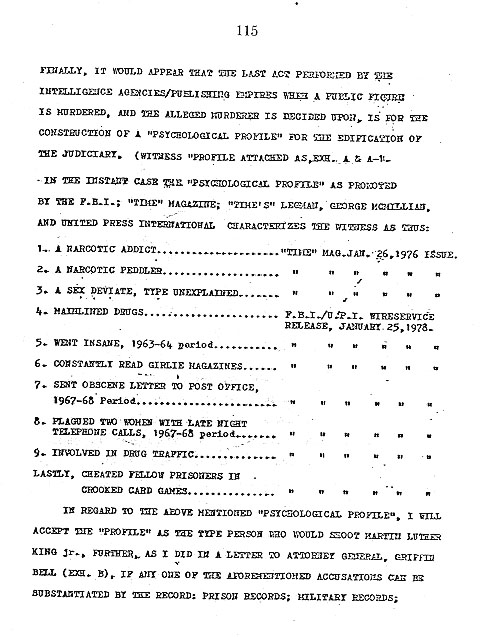
Finally, it would appear that the last act performed by the intelligence agencies/publishing empires when a public figure is murdered, and the alleged murderer is decided upon, is for the construction of a "psychological profile" for the edification of the judiciary. (Witness "profile attached as, EXH. A & A-H)
In the instant case the "psychological profile" as promoted by the F.B.I.; "Time" magazine; "Time's" legman, George McMillian, and the United Press International characterizes the witness as thus:
In regard to the above mentioned "psychological profile," I will accept the "profile" as the type person who would shoot Martin Luther King Jr., further, as I did in a letter to Attorney General, Griffin Bell (EXH. B), if any one of the aforementioned accusations can be substantiated by the record: prison records; military records;
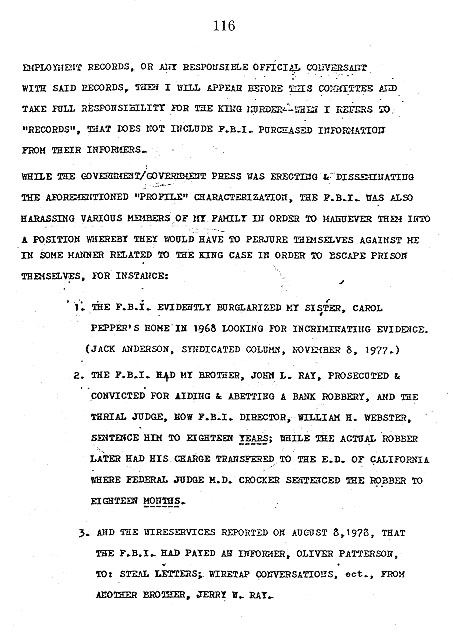
employment records, or any responsible official conversant with said records, then I will appear before this committee and take full responsibility for the King murder -- when I refers to "records," that does not include F.B.I. purchased information from their informers.
While the government/government press was erecting; disseminating the aforementioned "profile" characterization, F.B.I. was also harassing various members of my family in order to manuever them into a position whereby they would have to perjure themselves against me in some manner related to the King case in order to escape prison themselves, for instance:
1. The F.B.I. evidently burglarized my sister, Carol Pepper's home in 1968 looking for incriminating evidence. (Jack Anderson, Syndicated Column, November 8, 1977.)
2. The F.B.I. had my brother, John L. Ray, prosecuted & convicted for aiding & abetting a bank robbery, and the trial judge, now F.B.I. Director, William H. Webster, sentence him to eighteen years; while the actual robber later had his charge transfered to the E.D. of California where Federal judge M.D. Crocker sentence the robber to eighteen months.
3. And the wireservices reported on August 8, 1978, that the F.B.I. had payed an informer, Oliver Patterson, to: steal letters; wiretap conversations, ect., from another brother, Jerry W. Ray.
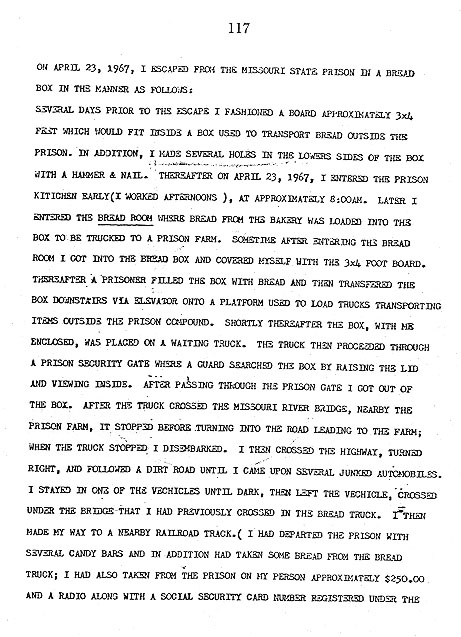
On April 23, 1967, I escaped from the Missouri State Prison in a bread box in the manner as follows:
Several days prior to the escape I fashioned a board approximately 3x4 feet which would fit inside a box used to transport bread outside the prison. In addition, I made several holes in the lower sides of the box with a hammer & nail. Thereafter on April 23, 1967, I entered the prison kitchen early (I worked afternoons), at approximately 8:00 AM. Later I entered the bread room where bread from the bakery was loaded into the box to be trucked to a prison farm. Sometime after entering the bread room I got into the bread box and covered myself with the 3x4 foot board. Thereafter a prisoner filled the box with bread and then transfered the box downstairs via elevator onto a platform used to load trucks transporting items outside the prison compound. Shortly thereafter the box, with me enclosed, was placed on a waiting truck. The truck then proceeded through a prison security gate where a guard searched the box by raising the lid and viewing inside. After passing through the prison gate I got out of the box. After the truck crossed the Missouri River bridge, nearby the prison farm, it stopped before turning into the road leading to the farm; when the truck stopped I disembarked. I then crossed the highway, turned right, and followed a dirt road until I came upon several junked automobiles. I stayed in one of the vehicles until dark, then left the vehicle, crossed under the bridge that I had previously crossed in the bread truck. I then made my way to a nearby railroad track. (I had departed the prison with several candy bars and in addition had taken some break from the bread truck; I had also taken from the prison on my person approximately $250.00 and a radio along with a Social Security card number registered
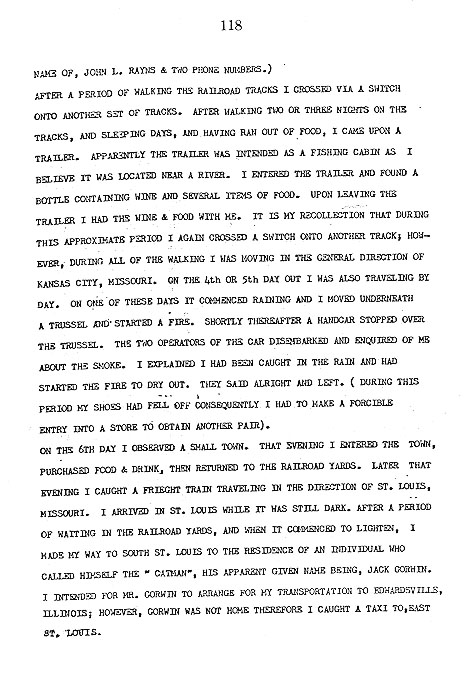
under the name of, John L. Rayns; two phone numbers.)
After a period of walking the railroad tracks I crossed via a switch onto another set of tracks. After walking two or three nights on the tracks, and sleeping days, and having ran out of food, I came upon a trailer. Apparently the trailer was intended as a fishing cabin as I believe it was located near a river. I entered the trailer and found a bottle containing wine and several items of food. Upon leaving the trailer I had the wine & food with me. It is my recollection that during this approximate period I again crossed a switch onto another track; however, during all of the walking I was moving in the general direction of Kansas City, Missouri. On the 4th or 5th day out I was also traveling by day. On one of these days it commenced raining and I moved underneath a trussel and started a fire. Shortly thereafter a handcar stopped over the trussel. The two operators of the car disembarked and enquired of me about the smoke. I explained I had been caught in the rain and had started the fire to dry out. They said alright and left. (During this period my shoes had fell off consequently I had to make a forcible entry into a store to obtain another pair.)
On the 6th day I observed a small town. That evening I entered the town, purchased food & drink, then returned to the railroad yards. Later that evening I caught a frieght train traveling in the direction of St. Louis, Missouri. I arrived in St. Louis to the residence of an individual who called himself the "Catman", his apparent given name being, Jack Gorwin. I intended for Mr. Gorwin to arrange for my transportation to Edwardsville, Illinois; however, Gorwin was not home therefore I caught a taxi to, East St. Louis.
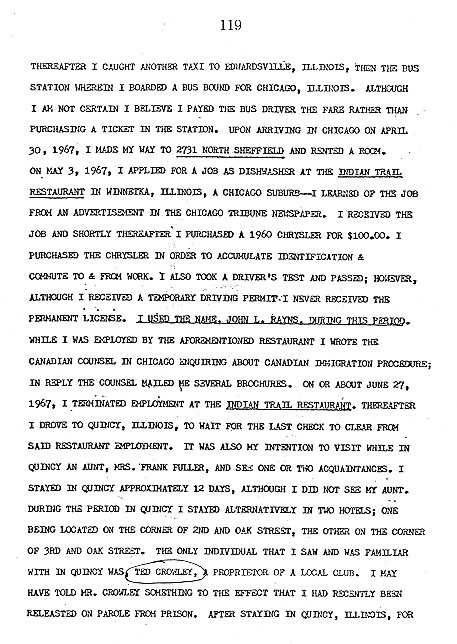
Thereafter I caught another taxi to Edwardsville, Illinois, then the bus station wherein I boarded a bus bound for Chicago, Illinois. Although I am not certain I believe I payed the bus driver the fare rather than purchasing a ticket in the station. Upon arriving in Chicago on April 30, 1967, I made my way to 2731 North Sheffield and rented a room. On May 3, 1967, I applied for a job as a dishwasher at the Indian Trail Restaurant in Winnetka, Illinois, a Chicago suburb -- I learned of the job from an advertisement in the Chicago Tribune newspaper. I received the job and shortly thereafter I purchased a 1960 Chrysler for $100.00. I purchased the Chrysler in order to accumulate identification & commute to & from work. I also took a driver's test and passed; however, although I received a temporary driving permit I never received the permanent license. I used the name John L. Rayns, during this period. While I was employed by the aforementioned restaurant I wrote the Canadian counsel in Chicago enquiring about Canadian immigration procedure; in reply the counsel mailed me several brochures. On or about June 27, 1967, I terminated employment at the Indian Trail Restaurant. Thereafter I drove to Quincy, Illinois, to wait for the last check to clear from said restaurant employment. It was also my intention to visit while in Quincy an aunt, Mrs. Frank Fuller, and see one or two acquaintances. I stayed in Quincy approximately 12 days, although I did not see my aunt. During the period in Quincy I stayed alternatively in two hotels; one being located on the corner of 2nd and Oak Street, the other on the corner of 3rd and Oak Street. The only individual that I saw and was familiar with in Quincy was, Ted Crowley, a priprietor of a local club. I may have told Mr. Crowley something to the effect that I had recently been released on parole from prison. After staying in Quincy, Illinois, for
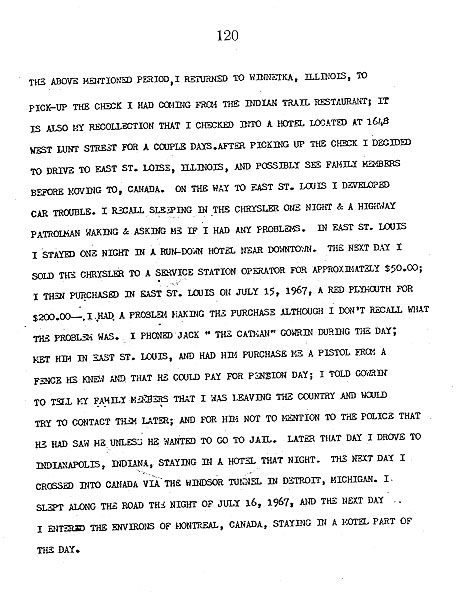
the above mentioned period, I returned to Winnetka, Illinois, to pick-up the check I had coming from the Indian Trail Restaurant; it is also my recollection that I checked into a hotel located at 1648 West Lunt Street for a couple days. After picking up the check I decided to drive to East St. Louis, Illinois, and possibly see family members before moving to, Canada. On the way to East St. Louis I developed car trouble. I recall sleeping in the Chrysler one night & a highway patrolman waking & asking me if I had any problems. In east St. Louis I stayed one night in a run-down hotel near downtown. The next day I sold the Chrysler to a service station operator for approximately $50.00; I then purchased in East St. Louis on July 15, 1967, a red Plymouth for $200.00 -- I had a problem making the purchase although I don't recall what the problem was. I phoned Jack "The Catman" Gowrin during the day; met him in East St. Louis, and had him puchase me a pistol from a fence he knew and that he could pay for pension day; I told Gowrin to tell my family members that I was leaving the country and would try to contact them later; and for him not to mention to the police that he had saw me unless he wanted to go to jail. Later that day I drove to Indianapolis, Indiana, staying in a hotel that night. The next day I crossed into Canada via the Windsor Tunnel in Detroit, Michigan. I slept along the road the night of July 16, 1967, and the next day I entered the environs of Montreal, Canada, staying in a motel part of the day.

the day I entered Montreal proper one of the first things I did was enquire of a travel agency, via telephone, the procedure for a Canadian to acquire a Canadian passport. I was informed that I must have a guarantor who would testify that he/she had known me for two years.) That evening in Montreal on St. Catherine East, in a night club, I was accosted by a prostitute, subsequently I agreed to go to her place via taxicab. After we got located in her apartment I gave her the requested $25.00 fee and she carried the money to an "office". When I left I wrote down the address of the building. The next day I rented an apartment in the, Har-K-Apartments, located at, 2589 Notre Dame East; then later, I parked my automobile closed to the building where I had the night before been with the prostitute. That evening I returned to the aforementioned night club and, meeting the same girl, again accompanied her via taxi to her apartment. Inside I gave her another $25.00 but this time I showed her the pistol Mr. Gorwin had purchased for me and told her I would go with her to where ever she was taking the money. When she aroused the manager into opening the "office" door I put the pistol on him. We moved back into the office wherein I asked him for the money. Taking out his wallet he offered me the small amount in it, about 5 or 10 dollars. When I told him I wanted the rest of the money, he spoke about a cabinet nearby and motioned to a container, before leaving the "office", I had the manager lie on a bed and the girl remove her stocking and tie his hands & legs. I then had her get under the bed before departing. Later I found I had taken approximately $1,700.00 in mixed currency from the manager's office.
During the next few days I purchased clothing and decided the only way
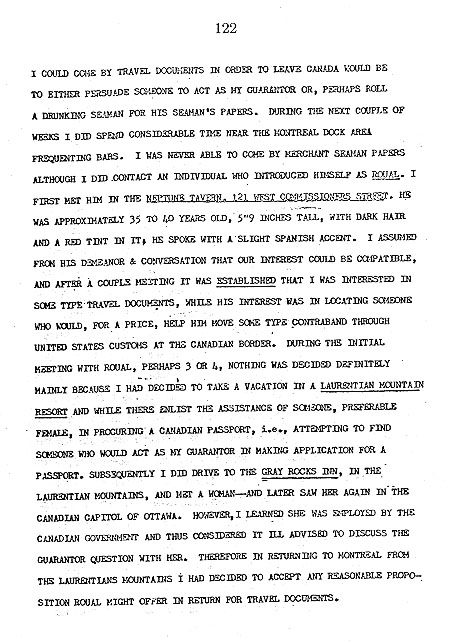
I could come by travel documents in order to leave Canada would be to either persuade someone to act as my guarantor or, perhaps roll a drunking seaman for his seaman's papers. During the next couple of weeks I did spend considerable time near the Montreal dock area frequenting bars. I was never able to come by merchant seaman papers although I did contact an individual who introduced himself as Roual. I first met him in the Neptune Tavern, 121 West Commissioners Street. He was approximately 35 to 40 years old, 5" 9 inches tall, with dark hair and a red tint in it. He spoke with a slight spanish accent. I assumed from his demeanor & conversation that our interest could be compatible, and after a couple meeting it was established that I was interested in some type travel documents, while his interest was in locating someone who would, for a price, help him move some type contraband through United States Customs at the Canadian border. During the initial meeting with Roual, perhaps 3 or 4, nothing was decided definitely mainly because I had decided to take a vacation in a Laurentian Mountain Resort and while there enlist the assistance of someone, preferable female, in procuring a Canadian passport, i.e., attempting to find someone who would act as my guarantor in making application for a passport. Subsequently I did drive to the Gray Rocks Inn, in the Laurentian Mountains, and met a woman -- and later saw her again in the Canadian Capitol of Ottowa. However, I learned she was employed by the Canadian Government and thus considered it ill advised to discuss the guarantor question with her. Therefore in returning to Montreal from the Laurentains Mountains I had decided to accept any reasonable proposal Roual might offer in return for travel documents.
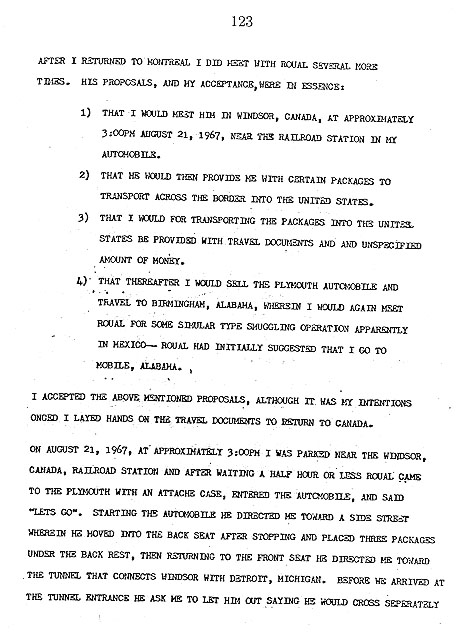
After I returned to Montreal I did meet with Roual several more times. His proposals, and my acceptance, were in essence:
1) That I would meet him in Windsor, Canada, at approximately 3:00PM August 21, 1967, near the railroad station in my automobile.
2) That he would then provide me with certain packages to transport across the border into the United States.
3) That I would for transporting the packages into the United States be provided with travel documents and an unspecified amount of money.
4) That thereafter I would sell the Plymouth automobile and travel to Birmingham, Alabama, wherein I would again meet Roual for some similar type smuggling operation apparently in Mexico -- Roual had initially suggested that I go to Mobile, Alabama.
I accepted the above mentioned proposals, although it was my intentions onced I layed hands on the travel documents to return to Canada.
On August 21, 1967, at approximately 3:00PM I was parked near the Windsor, Canada, railroad station and after waiting a half hour or less Roual came to the Plymouth with an attache case, entered the automobile, and said "Lets go". Starting the automobile he directed me toward a side street wherein he moved into the back seat after stopping and placed three packages under the back rest, then returning to the front seat he directed me toward the tunnel that connects Windsor with Detroit, Michigan. Before we arrived at the tunnel entrance he ask me to let him out saying he would cross separately
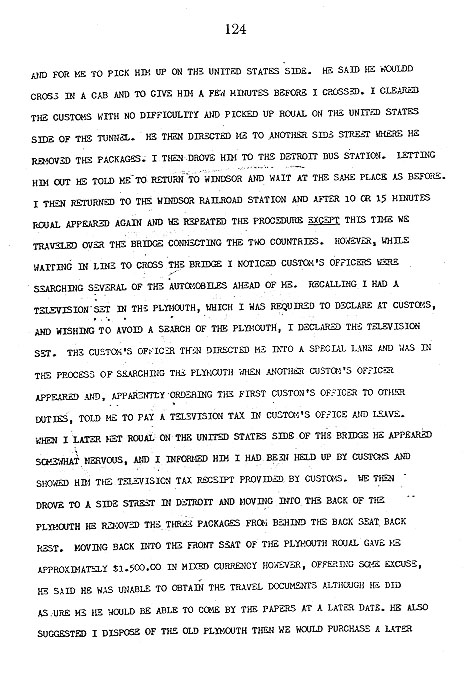
and for me to pick him up on the United States side. He said he would cross in a cab and to give him a few minutes before I crossed. I cleared the customs with no difficulty and picked up Roual on the United States side of the tunnel. He then directed me to another side street where he removed the packages. I then drove him to the Detroit bus station. Letting him out he told me to return to Windsor and wait at the same place as before. I then returned to the Windsor railroad station and after 10 or 15 minutes Roual appeared again and we repeated the procedure except this time we traveled over the bridge connecting the two countries. However, while waiting in line to cross the bridge I noticed custom's officers were searching several of the automobiles ahead of me. Recalling I had a television set in the Plymouth, which I was required to declare at customs, and wishing to avoid a search of the Plymouth, I declared the television set. The custom's officer then directed me into a special lane and was in the process of searching the Plymouth when another custom's officer appeared and, apparently ordering the first custom's officer to other duties, told me to pay a television tax in custom's office and leave. When I later met Roual on the United States side of the bridge he appeared somewhat nervous, and I informed him I had been held up by customs and showed him the television tax receipt provided by customs. We then drove to a side street in Detroit and moving into the back of the Plymouth he removed the three packages from behind the back seat back rest. Moving back into m front seat of the Plymouth Roual gave me approximately $1,500.00 in mixed currency however, offering some excuse, he said he was unable to obtain the travel documents although he did assure me he would be able to come by the papers at a later date. He also suggested I dispose of the old Plymouth then we would purchase a later
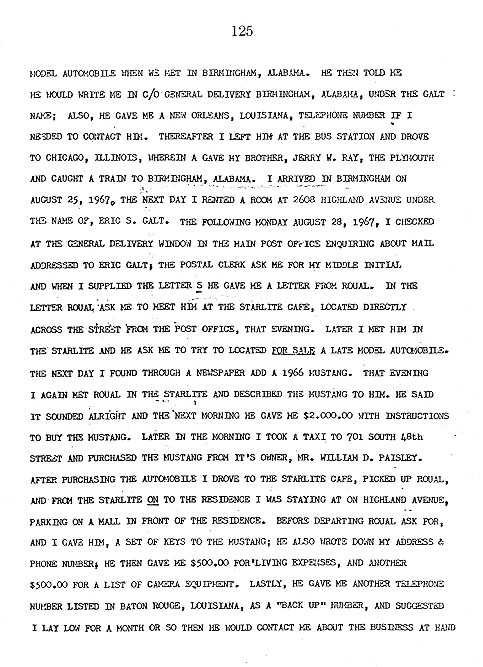
model automobile when we met in Birmingham, Alabama. He then told me he would write me in c/o general delivery Birmingham, Alabama, under the Galt name; also, he gave me a New Orleans, Louisiana, telephone number if I needed to contact him. Thereafter I left him at the bus station and drove to Chicago, Illinois, wherein a gave my brother, Jerry W. Ray, the Plymouth and caught a train to Birmingham, Alabama. I arrived in Birmingham on August 25, 1967. The next day I rented a room at 2608 Highland Avenue under the name of, Eric S. Galt. The following Monday August 28, 1967, I checked at the general delivery window in the main post office enquiring about mail addressed to Eric Galt; the postal clerk ask me for my middle initial and when I supplied the letter S he gave me a letter from Roual. In the letteer Roual ask me to meet him at the Starlite Cafe, located directly across the street from the post office, that evening. Later I met him in the Starlite and he ask me to try to located for sale a late model automobile. The next day I found through a newspaper add a 1966 Mustang. That evening I again met Roual in the Starlite and described the Mustang to him. He said it sounded alright and the next morning he gave me $2,000.00 with instructions to buy the Mustang. Later in the morning I took a taxi to 701 South 48th Street and purchased the Mustang from it's owner, Mr. William D. Paisley. After purchasing the automobile I drove to the Starlite Cafe, picked up Roual, and from the Starlite on to the residence I was staying at on Highland Avenue, parking on a mall in front of the residence. Before departing Roual ask for, and I gave him, a set of keys to the Mustang; he also wrote down my address & phone number; he then gave me $500.00 for living expenses, and another $500.00 for a list of camera equipment. Lastly, he gave me another telephone number listed in Baton Rouge, Louisiana, as a "back up" number, and suggested I lay low for a month or so then he would contact me about the business at hand
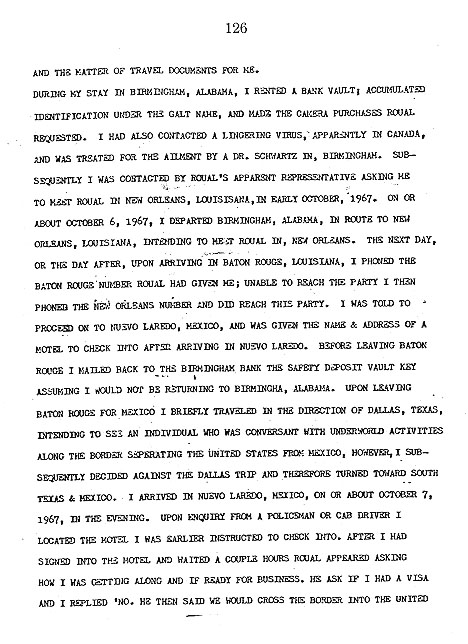
and the matter of travel documents for me.
During my stay in Birmingham, Alabama, I rented a bank vault; accumulated identification under the Galt name, and made the camera purchases Roual requested. I had also contacted a lingering virus, apparently in Canada, and was treated for the ailment by a Dr. Schwartz in, Birmingham. Subsequently I was contacted by Roual's apparent representative asking me to meet Roual in New Orleans, Louisiana, in early October, 1967. On or about October 6, 1967, I departed Birmingham, Alabama, in route to New Orleans, Louisiana, intending to meet Roual in, New Orleans. The next day, or the day after, upon arriving in Baton Rouge, Louisiana, I phoned the Baton Rouge number Roual had given me; unable to reach the party I then phoned the New Orleans number and did reach this party. I was told to proceed on to Nuevo Laredo, Mexico, and was given the name & address of a motel to check into after arriving in Nuevo Laredo. Before leaving Baton Rouge I mailed back to the Birmingham bank the safety deposit vault key assuming I would not be returning to Birmingham, Alabama. Upon leaving Baton Rouge for Mexico I briefly traveled in the direction of Dallas, Texas, intending to see an individual who was conversant with underworld activities along the border separating the United States and Mexico, however, I subsequently decided against the Dallas trip and therefore turned toward South Texas & Mexico. I arrived in Nuevo Laredo, Mexico, on or about October 7, 1967, in the evening. Upon enquiry from a policeman or cab driver I located the motel I was earlier instructed to check into. After I had signed into the motel and waited a couple hours Roual appeared asking how I was getting along and if ready for business. He ask if I had a visa and I replied no. He then said we would cross the border into the United
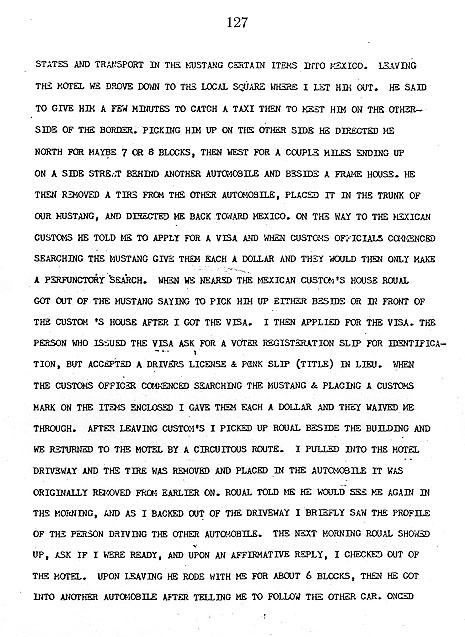
States and transport in the Mustang certain items into Mexico. Leaving the motel we drive down to the local square where I let him out. He said to give him a few minutes to catch a taxi then to meet him on the other side of the border. Picking him up on the other side he directed me north for maybe 7 or 8 blocks, then west for a couple miles ending up on a side street behind another automobile and beside a frame house. He then removed a tire from the other automobile, placed it in the trunk of our Mustang, and directed me back toward Mexico. On the way to the Mexican customs he told me to apply for a visa and when customs officials commenced searching the Mustang give them each a dollar and they would then only make a perfunctory search. When we neared the Mexican custom's house Roual got out of the Mustang saying to pick him up either beside or in front of the custom's house after I got the visa. I then applied for the visa. The person who issued the visa ask for a voter registration slip for identification, but accepted a drivers license & pink slip (title) in lieu. When the customs officer commenced searching the Mustang & placing a customs mark on the items enclosed I gave them each a dollar and they waived me through. After leaving custom's I picked up Roual beside the building and we returned to the motel by a circuitous route. I pulled into the motel driveway and the tire was removed and placed in the automobile it was originally removed from earlier on. Roual told me he would see me again in the morning, and as I backed out of the driveway I briefly saw the profile of the person driving the other automobile. The next morning Roual showed up, ask if I were ready, and upon an affirmative reply, I checked out of the motel. Upon leaving he rode with me for about 6 blocks, then he got into another automobile after telling me to follow the other car. Onced
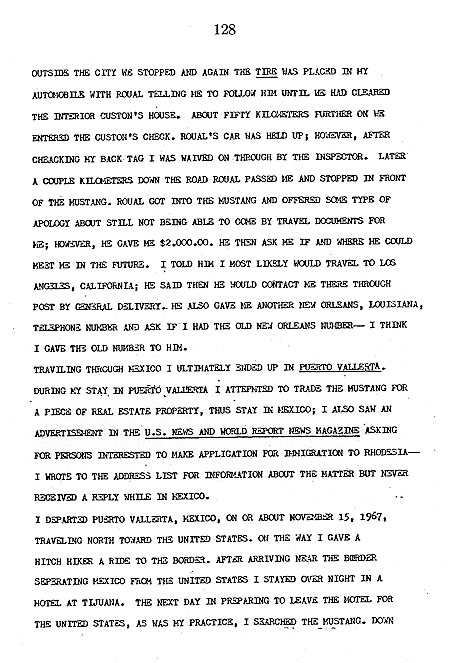
outside the city we stopped and again the tire was placed in my automobile with Roual telling me to follow him until we had cleared the interior custom's house. About fifty kilometers further on we entered the custom's house. About fifty kilometers further on we entered the custom's check. Roual's car was held up; however, after checking my back tag I was waived on through by the inspector. Later a couple kilometers down the road Roual passed me and stopped in front of the Mustang. Roual got into the Mustang and offered some type of apology about still not being able to come by travel documents for me; however, he gave me $2,000.00 He then ask me if and where he could meet me in the future. I told him I most likely would travel to Los Angeles, California; he said then he would contact me there through post by general delivery. He also gave me another New Orleans, Louisiana, telephone number and ask if I had the old New Orleans number -- I think I gave the old number to him.
Traveling through Mexico I ultimately ended up in Puerto Vallerta. During my stay in Puerto Vallerta I attempted to trade my Mustang for a piece of real estate property, thus stay in Mexico; I also saw an advertisement in the U.S. News and World Report News Magazine asking for persons interested to make application for immigration to Rhodesia -- I wrote to the address list for information about the matter but never received a reply while in Mexico.
I departed Puerto Vallerta, Mexico, on or about November 15, 1967, traveling north toward the United States. On the way I gave a hitch hiker a ride to the border. After arriving near the border separating Mexico from the United States I stayed over night in a motel at Tijuana. The next day in preparing to leave the motel for the United States, as was my practice, I searched the Mustang. Down
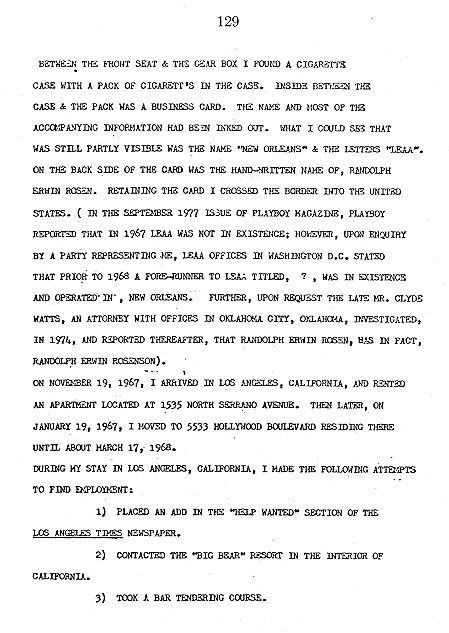
between the front seat & the gear box I found a cigarette case with a pack of cigarett's in the case. Inside between the case & the pack was a business card. The name and most of the accompanying information had been inked out. What I could see that was still partly visible was the name "New Orleans" & the letters "LEAA". On the back side of the card was the hand-written name of, Randolph Erwin Rosen. Retaining the card I crossed the border into the United States. (In the September 1977 issue of Playboy magazine, Playboy reported that in 1967 LEAA was not in existence; however, upon enquiry by a party representing me, LEAA offices in Washington, D.C. stated that prior to 1968 a fore-runner to LEAA titled, ?, was in existence and operated in, New Orleans. Further, upon request the late Mr. Clyde Watts, an attorney with offices in Oklahoma City, Oklahoma, investigated, in 1974, and reported thereafter, that Randolph Erwin Rosen, was in fact, Randolph Erwin Rosenson).
On November 19, 1967, I arrived in Los Angeles, California, and rented an apartment located at 1535 North Serrano Avenue. Then later, on January 19, 1967, I moved to 5533 Hollywood Boulevard residing there until about March 17, 1968.
During my stay in Los Angeles, California, I made the following attempts to find employment:
1) Placed an add in the "help wanted" section of the Los Angeles Times newspaper. 2) Contacted the "Big Bear" resort in the interior of California.
3) Took a bar tendering course.

4) Applied at two hotel for employment.
5) Filled out an application for employment with the Internal Revenue Service.
I made the following enquiries & acts in an attempt to leave the United States:
1) After reading in the local newspaper that United States citizens could travel to Columbia, South America, without a passport, I checked into this matter.
2) Contacted several organizations about information pertaining to Rhodesian immigration.
3) Phoned the United States Coast Guard several times enquiring about the procedure to follow in order to gain merchant seaman's papers -- in this respect, I had minor plastic surgery on my nose in March 1968 performed by, Dr. Russell Hadley, in order that I might change my appearance enough to avoid identification if I needed a picture for a merchant seaman papers.)
In early December 1967 I checked at the general delivery section, main post office, to see if Roual had posted any messages; finding that he had not sent a communication I phoned New Orleans under the number he had given me in Mexico. The person that answered enquired if I could travel to New Orleans in late December. I replied in the positive and thereafter made arrangements with a, Charley Stein, whom I had met in a local bar, to help with the driving to New Orleans. When Mr. Stein -- who was habitually short of money -- and I were ready to leave for New Orleans, about December 15, 1967, he ask to use my telephone in order to notify
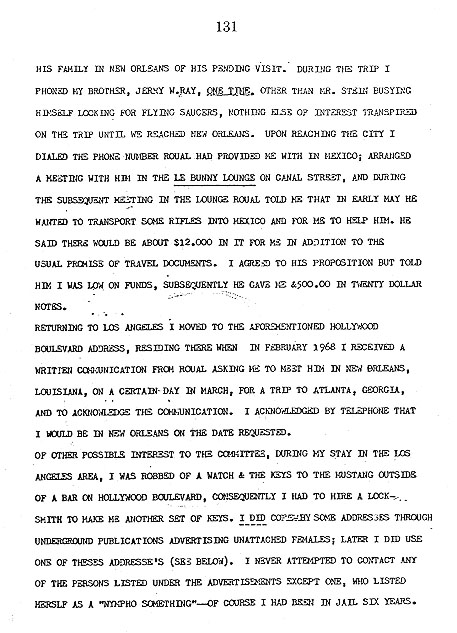
his family in New Orleans of his pending visit. During the trip I phoned my brother, Jerry W. Ray, one time. Other than Mr. Stein busying himself looking for flying saucers, nothing else of interest transpired on the trip until we reached New Orleans. Upon reaching the city I dialed the phone number Roual had provided me with in Mexico; arranged a meeting with him in the Le Bunny Lounge on Canal Street, and during the subsequent meeting in the lounge Roual told me that in early May he wanted to transport some rifles into Mexico and for me to help him. He said there would be about $12,000 in it for me in addition to the usual promise of travel documents. I agreed to his proposition but told him I was low on funds, subsequently he gave me $500.00 in twenty dollar notes.
Returning to Los Angeles I moved to the aforementioned Hollywood Boulevard address, residing there when in February 1968 I received a written communication from Roual asking me to meet him in New Orleans, Louisiana, on a certain day in March, for a trip to Atlanta, Georgia, and to acknowledge this communication. I acknowledged by telephone that I would be in New Orleans on the date requested.
Of other possible interest to the committee, during my stay in the Los Angeles area, I was robbed of a watch & the keys to the Mustang outside of a bar on Hollywood Boulevard, consequently I had to hire a locksmith to make me another set of keys. I did come by some addresses through underground publications advertising unattached females; later I did use one of these addresse's (see below). I never attempted to contact any of the persons listed under the advertisements except one, who listed herself as a "nympho something" -- of course I had been in jail six years.

on or about March 17, 1968, I departed Los Angeles for New Orleans, Louisiana. Apparently I was late in arriving in New Orleans: in calling the party under the aforementioned number I was told to drive to Birmingham, Alabama, and meet Roual in the Starlite Cafe. Arriving in Birmingham and entering the Starlite, again somewhat late, I met Roual and we proceeded on to Atlanta, Georgia. Arriving in Atlanta we commenced searching for an apartment finally locating a room for rent at 113 14th Street, Northeast; however, because of the intoxicated condition of the proprietor I had a problem renting the room and, because of the delay, Roual briefly entered the "office". After the rental we went to a restaurant on Peachtree Street for a meal, and while in the restaurant made arrangements for Roual to meet me at the recently rented room the next day. The next day, Roual came to the room I had rented (next door to the proprietor's office), and the conversation was a rerun of the previous evening's conversation in the Peachtree Street restaurant. In essence, I was to purchase rifles in Atlanta to be later shown to prospective buyers. But because of an identification problem, all of my identification was listed under the state of Alabama; I suggested we purchase the rifles in Alabama, which Roual agreed to do. Upon leaving Roual suggested I stay close to the room since he would return in a couple days and then wanted me to drive him to Miami, Florida -- however he never did appear for the Miami trip.
After about a week Roual did appear and we drove to Birmingham, Alabama, to implement what we had previously agreed to. I checked into the travel-lodge in Birmingham; we then checked through the yellow pages of the phone book, and perhaps newspapers, for an establishment that sold rifles,
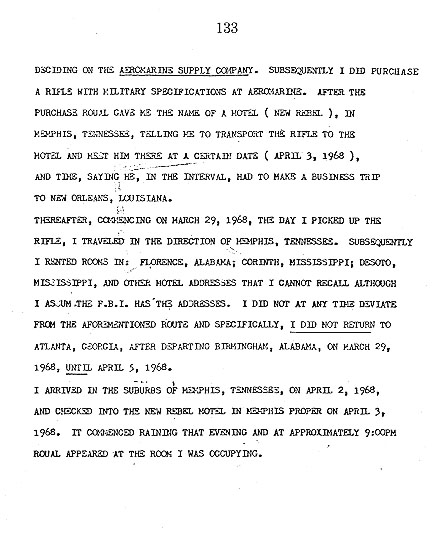
deciding on the Aeromarine Supply Company. Subsequently I did purchase a rifle with military specifications at Aeromarine. After the purchase Roual gave me the name of a motel (New Rebel), in Memphis, Tennessee, telling me to transport the rifle to the motel and meet him there at a certain date (April 3, 1968), and time, saying he, in the interval, had to make a business trip to New Orleans, Louisiana.
Thereafter, commencing on March 29, 1968, the day I picked up the rifle, I traveled in the direction of Memphis, Tennessee. Subsequently I rented rooms in: Florence, Alabama; Corinth, Mississippi; DeSoto, Mississippi, and other motel addresses that I cannot recall although I assume the F.B.I. has the addresses. I did not at any time deviate from the aforementioned route and specifically, I did not return to Atlanta, Georgia, after departing Birmingham, Alabama, on March 29, 1968, until April 5, 1968.
I arrived in the suburbs of Memphis, Tennessee, on April 2, 1968, and checked into the New Rebel Motel in Memphis proper on April 3, 1968. It commenced raining that evening and at approximately 9:00PM Roual appeared at the room I was occupying.
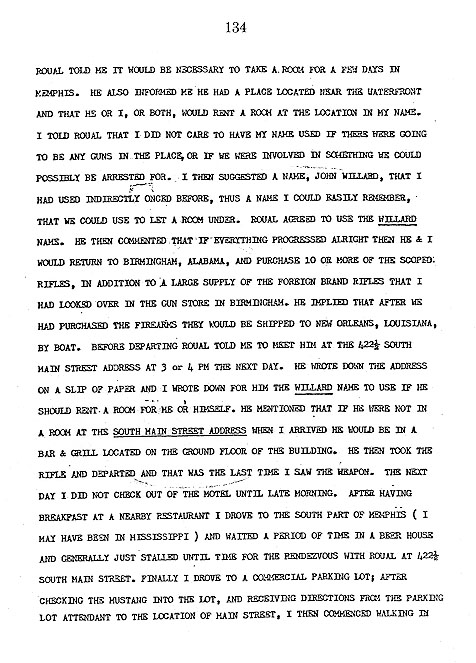
Roual told me it would be necessary to take a room for a few days in Memphis. He also informed me he had a place located near the waterfront and that he or I, or both, would rent a room at the location in my name. I told Roual that I did not care to have my name used if there were going to be any guns in the place, or if we were involved in something we could possibly be arrested for. I then suggested a name, John Willard, that I had used indirectly once before, thus a name I could easily remember, that we could use to let a room under. Roual agreed to use the Willard name. He then commented that if everything progressed alright then he & I would return to Birmingham, Alabama, and purchase 10 or more of the scoped rifles, in addition to a large supply of the foreign brand rifles that I had looked over in the gun store in Birmingham. He implied that after we had purchased the firearms they would be shipped to New Orleans, Louisiana, by boat. Before departing Roual told me to meet him at the 422 1/2 South Main Street address at 3 or 4 PM the next day. He wrote down the address on a slip of paper and I wrote down for him the Willard name to use if he should rent a room for me or himself. He mentioned that if he were not in a room at the South Main Streed address when I arrived he would be in a bar & grill located on the ground floor of the building. He then took the rifle and departed and that was the last time I saw the weapon. The next day I did not check out of the motel until late morning. After having breakfast at a nearby restaurant I drove to the south part of Memphis (I may have been in Mississippi) and waited a period of time in a beer house and generally just stalled until time for the rendezvous with Roual at 422 1/2 South Main Street. Finally I drove to a commercial parking lot; after checking the Mustang into the lot, and receiving directions from the parking lot attendant to the location of Main Street, I then commenced walking in
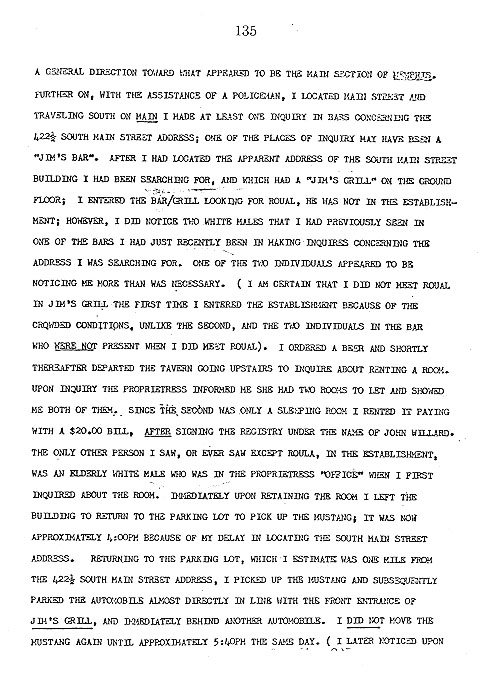
a general direction toward what appeared to be the main section of Memphis. Further on, with the assistance of a policeman, I located Main Street and traveling south on Main I made at least one inquiry in bars concerning the 422 1/2 South Main Street address; one of the places of inquiry may have been a "Jim's Bar". After I had located the apparent address of the South Main Street building I had been searching for, and which had a "Jim's Grill" on the ground floor; I entered the bar/grill looking for Roual, he was not in the establishment; however, I did notice two white males that I had previously seen in one of the bars I had just recently been in making inquiries concerning the address I was searching for. One of the two individuals appeared to be noticing me more than was necessary. (I am certain that I did not meet Roual in Jim's Grill the first time I entered the establishment because of the crowded conditions, unlike the second, and the two individuals in the bar who were not present when I did meet Roual). I ordered a beer and shortly thereafter departed the tavern going upstairs to inquire about renting a room. Upon inquiry the proprietress informed me she had two rooms to let and showed me both of them. Since the second was only a sleeping room I rented it paying with a $20.00 bill, after signing the registry under the name of John Willard. The only other person I saw, or even saw except Roual, in the establishment, was an elderly white mail who was in the proprietress "office" when I first inquired about the room. Immediately upon retaining the room I left the building to return to the parking lot to pick up the Mustang; it was now approximately 4:00PM because of my delay in locating the South Main Street address. Returning to the parking lot, which I estimate was one mile from the 422 1/2 South Main Street address, I picked up the Mustang and subsequently parked the automobile almost directly in line with the front entrance of Jim's Grill, and immediately behind another automobile. I did not move the Mustang again until approximately 5:40PM the same day. (I later noticed upon
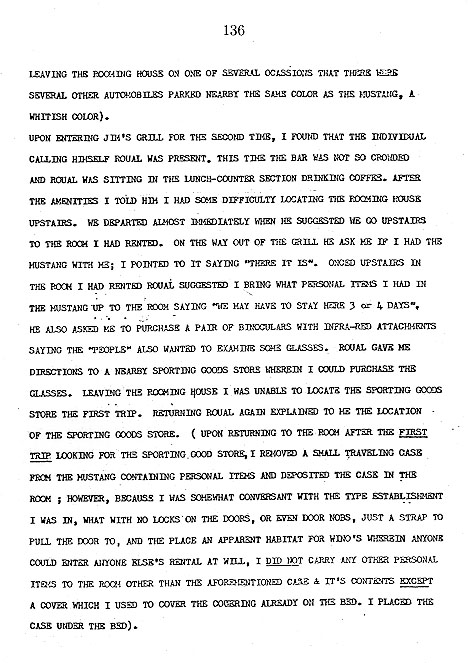
leaving the rooming house on one of several ocassions that there were several other automobiles parked nearby the same color as the Mustang, a whitish color).
Upon entering Jim's Grill for the second time, I found that the individual calling himself Roual was present, this time the bar was not so crowded and Roual was sitting in the lunch-counter section drinking coffee. After the amenities I told him I had some difficulty locating the rooming house upstairs. We departed almost immediately when he suggested we go upstairs to the room I had rented. On the way out of the grill he ask me if I had the Mustang with me; I pointed to it saying "there it is". Once upstairs in the room I had rented Roual suggested I bring what personal items I had in the Mustang up to the room saying "we may have to stay here 3 or 4 days", he also asked me to purchase a pair of binoculars with infra-red attachments saying the "people" also wanted to examine some glasses. Roual gave me directions to a nearby sporting goods store wherein I could purchase the glasses. Leaving the rooming house I was unable to locate the sporting goods store the first trip. Returning Roual again explained to me the location of the sporting goods store. (Upon returning to the room after the first trip looking for the sporting goods store, I removed a small traveling case from the Mustang containing personal items and deposited the case in the room; however, because I was somewhat conversant with the type establishment I was in, what with no locks on the doors, or even door nobs, just a strap to pull the door to, and the place an apparent habitat for wino's wherein anyone could enter anyone else's rental at will, I did not carry any other personal items to the room other than the aforementioned case & it's contents except a cover which I used to cover the covering already on the bed. I placed the case under the bed.

on the second trip seeking the sporting goods store I located it. Upon inquiry the salesman informed me that the store did not carry infra-red attachments for binoculars and that I would have to purchase them at an army surplus store; however the salesman did sell me binoculars. On the way back to the rooming house I stopped at a drugstore on the ground floor of the Chisca Hotel and ordered ice cream. While waiting on the order I sat, as customary, directly across from the cash register and distinctly recall the apparent manager, who was a white male, instructing a young black woman on the intricacies of the cash register, thus I assume she had just started working in the store that day. (The attorneys representing me in the King case in 1968-69 were unable to locate the drugstore in question; however, in February 1969 I described to a policeman, who was guarding me in the Memphis jail cell, the approximate location of the store and he informed me the name of the store).
After returning to the Main Street rooming house I told Raoul we would have to purchase the infra-red attachments at an army surplus store; I also informed him that I had not eaten since breakfast. He said to go out and have a meal & take in a movie since he wanted to see some people in private that evening but, to leave the Mustang out in front as he would most likely need it that evening or night. I then went down stairs into Jim's Grill and ordered a beer although I did not drink it... I say this because I recall seeing a white waitress on one ocassion while I was in the establishment, and on the next ocassion there was a black waitress on duty. Leaving the grill I sat in the Mustang 10 or 15 minutes before traveling north on Main Street and entering a bar & restaurant located on the left hand side of the street and fairly near to a movie house across the street. I ordered a
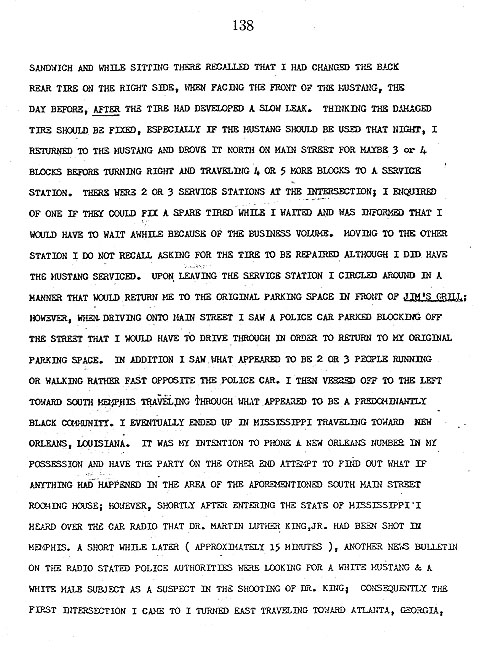
sandwich and while sitting there recalled that I had changed the back rear tire on the right side, when facing the front of the Mustang, the day before, after the tire had developed a slow leak. Thinking the damaged tire should be fixed, especially if the Mustang should be used that night, I returned to the Mustang and drove it north on Main Street for maybe 3 or 4 blocks before turning right and traveling 4 or 5 more blocks to a service station. There were 2 or 3 service stations at the intersection; I enquired of one if they could fix a spare tired while I waited and was informed that I would have to wait awhile because of the business volume. Moving to the other station I do not recall asking for the tire to be repaired although I did have the Mustang serviced. Upon leaving the service station I circled around in a manner that would return me to the original parking space in front of Jim's Grill; however, when driving on to Main Street I saw a police car parked blocking off the street that I would have to drive through in order to return to my original parking space. In addition I saw what appeared to be 2 or 3 people running or walking rather fast opposite the police car. I then veered off to the left toward South Memphis traveling through what appeared to be a predominantly black community. I eventually ended up in Mississippi traveling toward New Orleans, Louisiana. It was my intention to phone a New Orleans number in my possession and have the party on the other end attempt to find out what if anything had happened in the area of the aforementioned South Main Street rooming house; however, shortly after entering the state of Mississippi I heard over the car radio that Dr. Martin Luther King, Jr. had been shot in Memphis. A short while later (approximately 15 minutes), another news bulletin on the radio stated police authorities were looking for a white Mustang & a white male subject as a suspect in the shooting of Dr. King; consequently the first intersection I came to I turned east traveling toward Atlanta, Georgia,
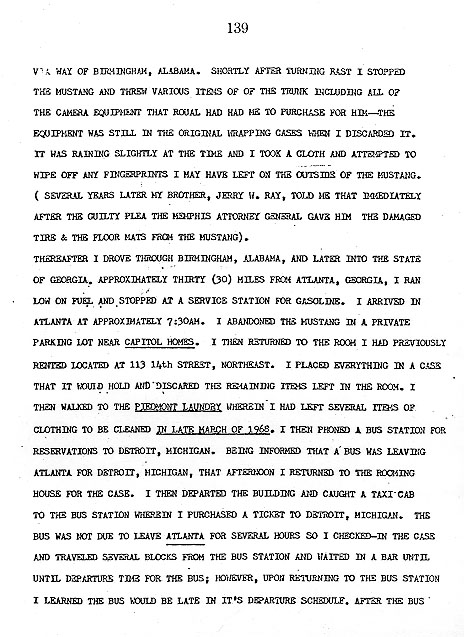
via way of Birmingham, Alabama. Shortly after turning east I stopped the Mustang and threw various items of the trunk including all of the camera equipment that Roual had had me to purchase for him -- the equipment was still in the original wrapping cases when I discarded it. It was raining slightly at the time and I took a cloth and attempted to wipe off any fingerprints I may have left on the outside of the Mustang. (Several years later my brother, Jerry W. Ray, told me that immediately after the guilty plea the Memphis attorney general gave him the damaged tire & the floor mats from the Mustang).
Thereafter I drove through Birmingham, Alabama, and later into the state of Georgia. Approximately thirty (30) miles from Atlanta, Georgia, I ran low on fuel and stopped at a service station for gasoline. I arrived in Atlanta at approximately 7:30AM. I abandoned the Mustang in a private parking lot near Capitol Homes. I then returned to the room I had previously rented located at 113 14th Street, Northeast. I placed everything in a case that it would hold and discard the remaining items left in the room. I then walked to the Piedmont Laundry wherein I had left several items of clothing to be cleaned in late March of 1968. I then phoned a bus station for reservations to Detroit, Michigan. Being informed that a bus was leaving Atlanta for Detroit, Michigan, that afternoon I returned to the rooming house for the case. I then departed the building and caught a taxi cab to the bus station wherein I purchased a ticket to Detroit, Michigan. The bus was not due to leave Atlanta for several hours so I checked-in the case and traveled several blocks from the bus station and waited in a bar until departure time for the bus; however, upon returning to the bus station I learned the bus would be late in it's departure schedule. After the bus
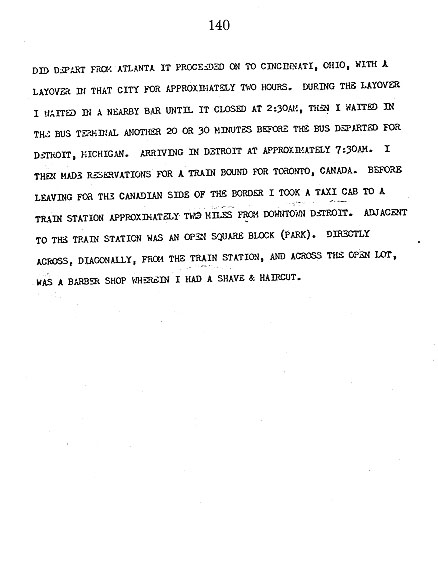
did depart from Atlanta it proceeded on to Cincinnati, Ohio, with a layover in that city for approximately two hours. During the layover I waited in a nearby bar until it closed at 2:30AM, then I waited in the bus terminal another 20 or 30 minutes before the bus departed for Detroit, Michigan. Arriving in Detroit at approximately 7:30AM. I then made reservations for a train bound for Toronto, Canada. Before leaving for the Canadian side of the border I took a taxi cab to a train station approximately two miles from downtown Detroit. Adjacent to the train station was an open square block (park). Directly across, diagonally, from the train station, and across the open lot, was a barber shop wherein I had a shave & haircut.
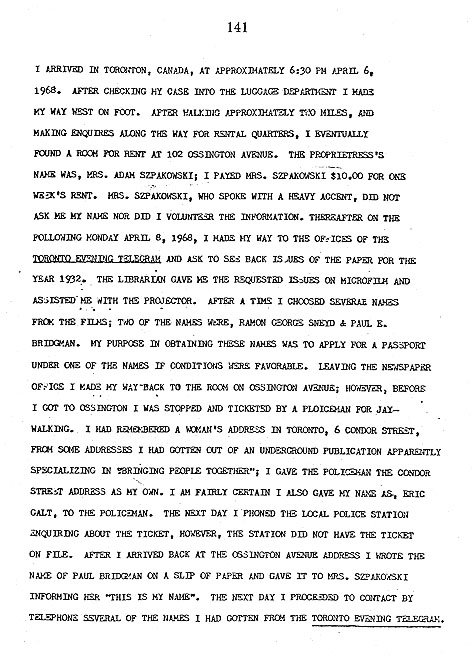
I arrived in Toronto, Canada, at approximately 6:30PM April 6, 1968. After checking my case into the luggage department I made my way west on foot. After walking approximately two miles, and making enquiries along the way for rental quarters, I eventually found a room for rent at 102 Ossington Avenue. The proprietress's name was, Mrs. Adam Szpakowski; I payed Mrs. Szpakowski $10.00 for one week's rent. Mrs. Szpakowski, who spoke with a heavy accent, did not ask me my name nor did I volunteer the information. Thereafter on the following Monday April 8, 1968, I made my way to the offices of the Toronto Evening Telegram and ask to see back issues of the paper for the year 1932. The librarian gave me the requested issues of the paper for the year 1932. The librarian gave me the requested issues on microfilm and assisted me with the projector. After a time I choosed several names from the films; two of the names were, Ramon George Sneyd & Paul E. Bridgman. My purpose in obtaining these names was to apply for a passport under one of the names if conditions were favorable. Leaving the newspaper office I made my way back to the room on Ossington Avenue; however, before I got to Ossington I was stopped and ticketed by a policeman for jay-walking. I had remembered a woman's address in Toronto, 6 Condor Street, for some addresses I had gotten out of an underground publication apparently specializing in "bringing people together"; I gave the policeman the Condor Street address as my own. I am fairly certain I also gave my name as, Eric Galt, to the policeman. The next day I phoned the local police station enquiring about the ticket, however, the station did not have the ticket on file. After I arrived back at the Ossington Avenue address I wrote the name of Paul Bridgman on a slip of paper and gave it to Mrs. Szpakowski informing her "this is my name". The next day I proceeded to contact by telephone several of the names I had gotten from the Toronto Evening Telegram.
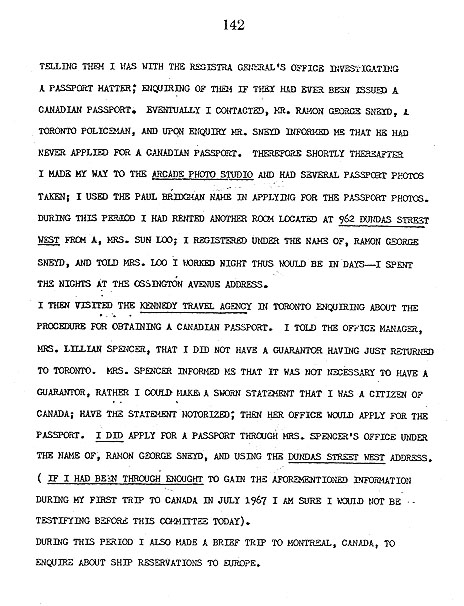
telling them I was with the registra general's office investigating a passport matter; enquiring of them if they had ever been issued a Canadian passport. Eventually I contacted, Mr. Ramon George Sneyd, a Toronto policeman, and upon enquiry Mr. Sneyd informed me that he had never applied for a Canadian passport. Therefore shortly thereafter I made my way to the Arcade Photo Studio and had several passport photos taken; I used the Paul Bridgman name in applying for the passport photos. During this period I had rented another room located at 962 Dundas Street West from A, Mrs. Sun Loo; I registered under the name of, Ramon George Sneyd, and told Mrs. Loo I worked night thus would be in days -- I spent the nights at the Ossington Avenue address.
I then visited the Kennedy Travel Agency in Toronto enquiring about the procedure for obtaining a Canadian passport. I told the office manager, Mrs. Lillian Spencer, that I did not have a guarantor having just returned to Toronto. Mrs. Spencer informed me that it was not necessary to have a guarantor, rather I could make a sworn statement that I was a citizen of Canada; have the statement notorized; then her office would apply for the passport. I did apply for a passport through Mrs. Spencer's office under the name of, Ramon George Sneyd, and using the Dundas Street West address. (If I had been through enough to gain the aforementioned information during my first trip to Canada in July 1967 I am sure I would not be testifying before this committee today).
During this period I also made a brief trip to Montreal, Canada, to enquire about ship reservations to Europe.
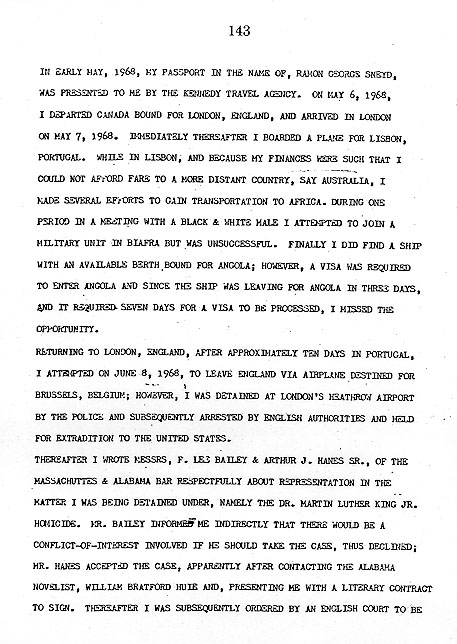
in early May, 1968, my passport in the name of, Ramon George Sneyd, was presented to me by the Kennedy Travel Agency. On May 6, 1968, I departed Canada bound for London, England, and arrived in London on May 7, 1968. Immediately thereafter I boarded a plane for Lisbon, Portugal. While in Lisbon, and because my finances were such that I could not afford fare to a more distant country, say Australia, I made several efforts to gain transportation to Africa. During one period in a meeting with a black & white male I attempted to join a military unit in Biafra but was unsuccessful. Finally I did find a ship with an available berth bound for Angola; however, a visa was required to enter Angola and since the ship was leaving for Angola in three days, and it required seven days for a visa to be processed, I missed the opportunity.
Returning to London, England, after approximately ten days in Portugal, I attempted on June 8, 1968, to leave England via airplane destined for Brussels, Belgium; however, I was detained at London's Heathrow Airport by the police and subsequently arrested by English authorities and held for extradition to the United States.
Thereafter I wrote Messrs, F. Lee Bailey & Arthur J. Hanes Sr., of the Massachuttes & Alabama bar respectfully about representation in the matter I was being detained under, namely the Dr. Martin Luther King Jr. homicide. Mr. Bailey informed me indirectly that there would be a conflict-of-interest involved if he should take the case, thus declined; Mr. Hanes accepted the case, apparently after contacting the Alabama novelist, William Bratford Huie and, presenting me with a literary contract to sign. Thereafter I was subsequently ordered by an English court to be
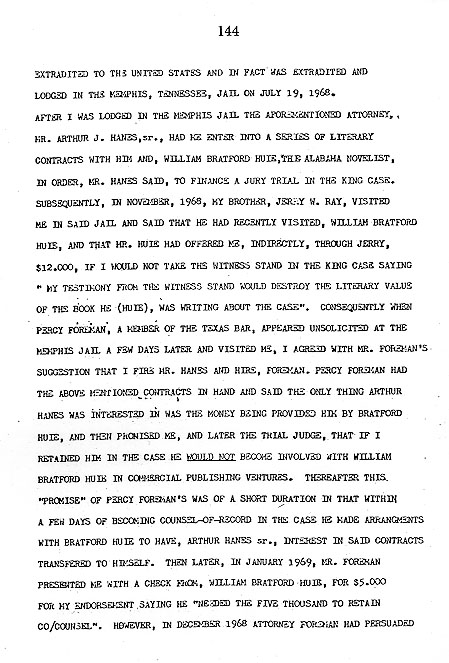
extradited to the United States and in fact was extradited and lodged in the Memphis, Tennessee, jail on July 19, 1968. After I was lodged in the Memphis jail the aforementioned attorney, Mr. Arthur J. Hanes, Sr., had me enter into a series of literary contracts with him and, William Bratford Huie, the Alabama novelist, in order, Mr. Hanes said, to finance a jury trial in the King case. Subsequently, in November, 1968, my brother, Jerry W. Ray, visited me in said jail and said that he had recently visited, William Bratford Huie, and that Mr. Huie had offered me, indirectly, through Jerry, $12,000, if I would not take the witness stand in the King case saying "My testimony from the witness stand would destroy the literary value of the book he (Huie), was writing about the case". Consequently when Percy Foreman, a member of the Texas bar, appeared unsolicited at the Memphis jail a few days later and visited me, I agreed with Mr. Foreman's suggestion that I fire Mr. Hanes and hire, Foreman. Percy Foreman had the above mentioned contracts in hand and said the only thing Arthur Hanes was interested in was the money being provided him by Bratford Huie, and then promised me, and later the trial judge, that if I retained him in the case he would not become involved with William Bratford Huie in commercial publishing ventures. Thereafter this "promise" of Percy Foreman's was of a short duration in that within a few days of becoming counsel-of-record in the case he made arrangements with Bratford Huie to have, Arthur Hanes Sr., Mr. Foreman presented me with a check from, William Bratford Huie, for $5,000 for my endorsement saying he "needed the five thousand to retain co/counsel". However, in December 1968 attorney Foreman had persuaded
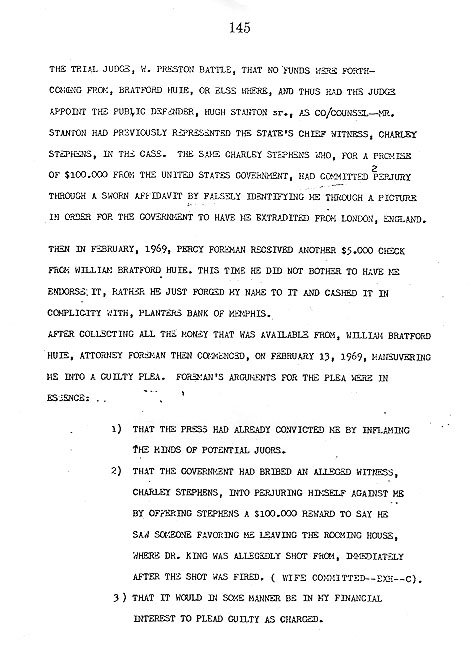
the trial judge, W. Preston Battle, that no funds were forthcoming from, Bratford Huie, or else where, and thus had the judge appoint the public defender, Hugh Stanton Sr., as co/counsel -- Mr. Stanton had previously represented the state's chief witness, Charley Stephens, in the case. The same Charley Stephens who, for a promise of $100,000 from the United States government, had committed perjury through a sworn affidavit by falsely identifying me through a picture in order for the government to have me extradited from London, England.
Then in February, 1969, Percy Foreman received another $5,000 check from William Bratford Huie. This time he did not bother to have me endorse it, rather he just forged my name to it and cashed it in complicity with, Planters Bank of Memphis.
After collecting all the money that was available from, William Bratford Huie, attorney Foreman then commenced, on February 13, 1969, maneuvering me into a guilty plea. Foreman's arguments for the plea were in essence:
1) That the press had already convicted me by inflaming the minds of potential juors.
2) That the government had bribed an alleged witness, Charley Stephens, into perjuring himself against me by offering Stephens a $100,000 reward to say he saw someone favoring me leaving the rooming house, where Dr. King was allegedly shot from, immediately after the shot was fired.
3) That it would in some manner be in my financial interest to plead guilty as charged.
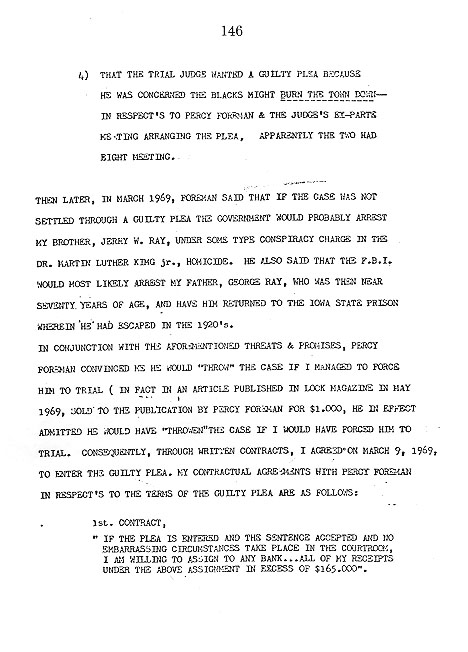
4) That the trial judge wanted a guilty plea because he was concerned the blacks might burn the town down -- in respect's to Percy Foreman; the judge's ex-parte meeting arranging the plea, apparently the two had eight meeting.
Then later, in March 1969, Foreman said that if the case was not settled through a guilty plea the government would probably arrest my brother, Jerry W. Ray, under some type conspiracy charge in the Dr. Martin Luther King Jr., homicide. He also said that the F.B.I. would most likely arrest my father, George Ray, who was then near seventy years of age, and have him returned to the Iowa state prison wherein he had escaped in the 1920's.
In conjunction with the aforementioned threats & promises, Percy Foreman convinced me he would "throw" the case if I managed to force him to trial (in fact in an article published in Look magazine in May 1969, sold to the publication by Percy Foreman for $1,000, he in effect admitted he would have "thrown" the case if I would have forced him to trial. Consequently, through written contracts, I agreed on March 9, 1969, to enter the guilty plea. My contractual agreements with Percy Foreman in respect's to the terms of the guilty plea are as follows:
1st. Contract,
"If the plea is entered and the sentence accepted and no embarrassing circumstances take place in the courtroom, I am willing to assign to any bank... all of my receipts under the above assignment in excess of $165,000."
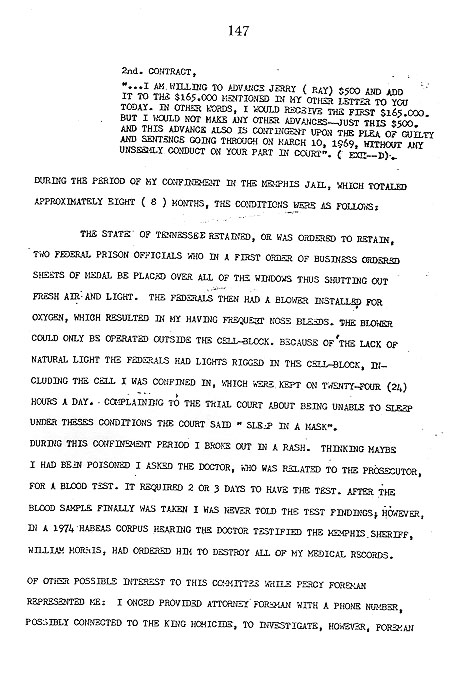
2nd. Contract,
"...I am willing to advance Jerry (Ray) $500 and add it to the $165,000 mentioned in my other letter to you today. In other words, I would receive the first $165,000. But I would not make any other advances -- just this $500. And this advance also is contingent upon the plea of guilty and sentence going through on March 10, 1969, without any unseemly conduct on your part in court".
During the period of my confinement in the Memphis jail, which totalled approximately eight (8) months, the conditions were as follows:
The state of Tennessee retained, or was ordered to retain, two Federal prison officials who in a first order of business ordered sheets of medal be placed over all of the windows thus shutting out fresh air and light. The Federals then had a blower installed for oxygen, which resulted in my having frequent nose bleeds. The blower could only be operated outside the cell-block. Because of the lack of natural light the Federals had lights rigged in the cell-block, including the cell I was confined in, which were kept on twenty-four (24) hours a day, complaining to the trial court about being unable to sleep under these conditions the court said "sleep in a mask".
During this confinement period I broke out in a rash. Thinking maybe I had been poisoned I asked the doctor, who was related to the prosecutor, for a blood test. It required 2 or 3 days to have the test. After the blood sample finally was taken I was never told the test findings; however, in a 1974 habeas corpus hearing the doctor testified the Memphis sheriff, William Morris, had ordered him to destroy all of my medical records.
Of other possible interest to this committee while Percy Foreman represented me: I once provided attorney Foreman with a phone number, possibly connected to the King homicide, to investigate, however, Foreman
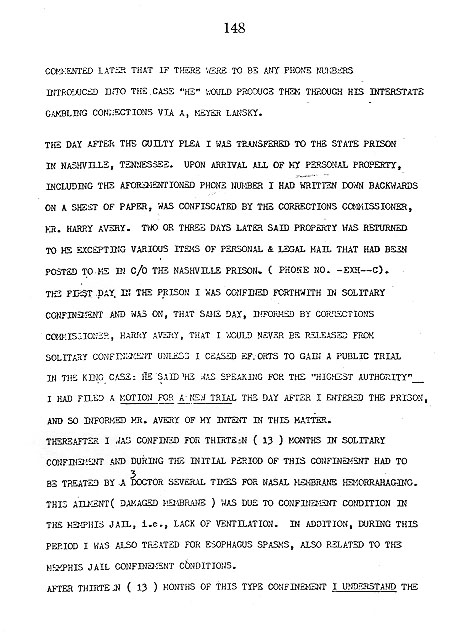
commented later that if there were to be any phone numbers introduced into the case "he" would produce them through his interstate gambling connections via a, Meyer Lansky.
The day after the guilty plea I was transferred to the state prison in Nashville, Tennessee. Upon arrival all of my personal property, including the aforementioned phone number I had written down backwards on a sheet of paper, was confiscated by the corrections commissioner, Mr. Harry Avery. Two or three days later said property was returned to me excepting various items of personal & legal mail that had been posted to me in c/o the Nashville prison. (Phone No. - EXH--C). The first day in the prison I was confined forthwith in solitary confinement and was on, that same day, informed by corrections commissioner, Harry Avery, that I would never be released from solitary confinement unless I ceased efforts to gain a public trial in the King case: he said he was speaking for the "highest authority". I had filed a motion for a new trial the day after I entered the prison, and so informed Mr. Avery of my intent in this matter.
Thereafter I was confined for thirteen (13) months in solitary confinement and during the initial period of this confinement had to be treated by a doctor several times for nasal membrane hemorrahaging. This ailment (damaged membrane) was due to confinement condition in the Memphis jail, i.e., lack of ventilation. In addition, during this period I was also treated for esophagus spasms, also related to the Memphis jail confinement conditions.
After thirteen (13) months of this type confinement I understand the
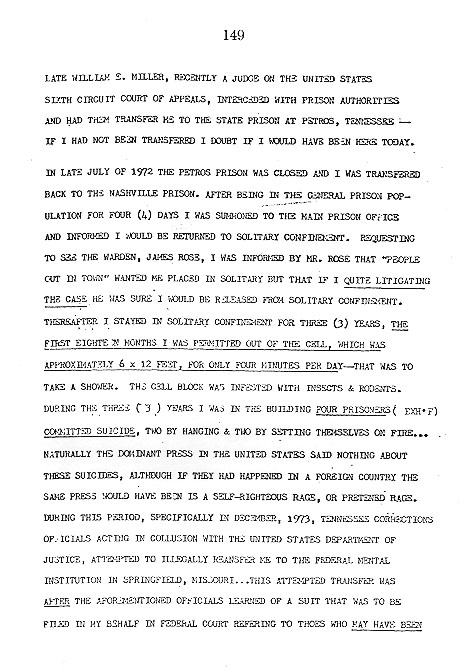
late William E. Miller, recently a judge on the United States Sixth Circuit Court of Appeals, interceded with prison authorities and had them transfer me to the state prison at Petros, Tennessee -- if I had not been transferred I doubt if I would have been here today.
In late July of 1972 the Petros prison was closed and I was transferred back to the Nashville prison. After being in the general prison population for four (4) days I was summoned to the main prison office and informed I would be returned to solitary confinement. Requesting to see the warden, James Rose, I was informed by Mr. Rose that "people in town" wanted me placed in solitary but that if I quite litigating the case he was sure I would be released from solitary confinement. Thereafter I stayed in solitary confinement for three (3) years, the first eighteen months I was permitted out of the cell, which was approximately 6 x 12 feet, for only four minutes per day -- that was to take a shower. The cell block was infested with insects & rodents. During the three (3) years I was in the building four prisoners committed suicide, two by hanging & two by setting themselves on fire... naturally the dominant press in the United States said nothing about these suicides, although if they had happened in a foreign country the same press would have been is a self-righteous rage, or pretened rage. During this period, specifically in December, 1973, Tennessee corrections officials acting in collusion with the United States Department of Justice, attempted to illegally transfer me to the Federal mental institution in Springfield, Missouri... this attempted transfer was after the aforementioned officials learned of a suit that was to be filed in my behalf in Federal court refering to those who may have been
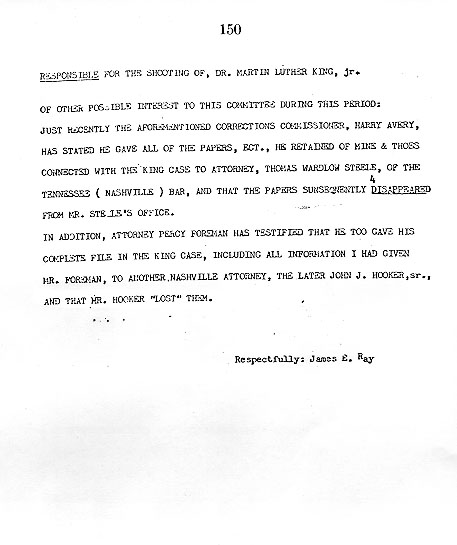
responsible for the shooting of, Dr. Martin Luther King, Jr.
Of other possible interest to this committee during this period: just recently the aforementioned corrections commissioner, Harry Avery, has stated he gave all of the papers, ect., he retained of mine & those connected with the King case to attorney, Thomas Wardlow Steele, of the Tennessee (Nashville) bar, and that the papers subsequently disappeared from Mr. Steele's office.
In addition, attorney Percy Foreman has testified that he too gave his complete file in the King case, including all information I had given Mr. Foreman, to another Nashville attorney, the later John J. Hooker, Sr., and that Mr. Hooker "lost" them.
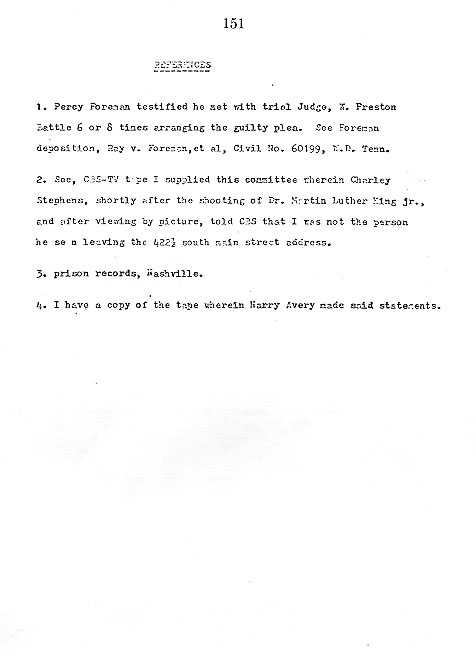
REFERENCES
1. Percy Foreman testified he met with trial Judge, W. Preston Battle 6 or 8 times arranging the guilty plea. See Foreman deposition, Ray v. Foreman, et al, Civil No. 60199, W.D. Tenn.
2. See, CBS-TV tape I supplied this committee therein Charley Stephens, shortly after the shooting of Dr. Martin Luther King Jr., and after viewing my picture, told CBS that I was not the person he seen leaving the 422 1/2 South Main Street address.
3. Prison records, Nashville.
4. I have a copy of the tape wherein Harry Avery made said statements.
Holdups Finances Ray's Flight, FBI Says
WASHINGTON (UPI) -- The FBI concluded James Earl Ray financed his global escape from Memphis after killing Martin Luther King through a series of petty robberies and was not controlled by co-conspirators, FBI files disclosed yesterday.
Internal FBI documents, amassed in the largest manhunt in history, [illegible] Ray was planning a flight to South Africa or Rhodesia a few days before his arrest by Scotland Yard, at London's Heathrow Airport on June 8, 1968, two months after King was gunned down, on the motel balcony in Memphis.
The reports -- made available under the Freedom of Information Act -- also showed a strong streak of racism and pro-Nazi feelings may have led Ray to assassinate the man who most symbolized back refusal to accept anything but equal status in America.
Just a few weeks before King's murder, Ray and a companion, Charles Stein, drove from Los Angeles to New Orleans and back, in the course of that [illegible] Ray gave vent to his racial feelings.
"If NEGROES want to be free, they should go north or west," Stein quoted Ray. "If they stay in the South, they should be willing to be slaves."
An uncle told agents Ray may have been influenced against blacks and Jews by "pro-Nazis" in a Quincy, Ill., tannery where he worked as a youth and by his Army service in Germany where the uncle said Ray's attitude crystalized. He was discharged from the Army for [illegible] and lack of adaptability.
Ray first pleaded innocent, but stunned the court when his case came to trial March 10, 1969, by changing his plea to guilty. He was sentenced to 99 years.
He since has made numerous unsuccessful appeals, and last fall escaped from Brushy Mountain State Prison in Tennessee. He was apprehended a short time later.
Upon his guilty plea, Ray told Judge W. Preston Battle he could "not accept" the statements of the prosecutor and his attorney that he had acted alone, without aid from any co-conspirator.
Ever since, there has been speculation that Ray, a drifter who had spent most of his life in jail, had been bankrolled by forces eager to silence King, a Nobel Peace Prize winner.
As recently as June 27, 1974, however, the FBI files showed, the bureau concluded it could find "nothing to indicate that Ray ever received any large sum of money from anyone, and what we know of his living habits both before and after the murder would indicate that he lived on a very limited amount of money.
"We do not know the source of even the smallest amount of money possessed by Ray, but since we know him to have robbed a bank in England after fleeing to that country, it is a reasonable presumption that Ray committed robberies in the United States during the same time he was a fugitive," the FBI said.
The more than 40,000 pages of FBI reports carried other hints of where Ray obtained money to pay $1995 for a white Mustang to escape from Memphis; $134.95 for the 30.06 Remington pump rifle and $74.60 for Redfield scope telescopic sight he used to kill King, and the funds to reach Canada, and to pay for his round trip plane ticket to London.
There were indications Ray was heavily involved in drug traffic -- in prison for four years prior to the slaying -- one prisoner said he "mainlined" amphetamines and barbiturates, and there was testimony from another convict who said Ray "cheated fellow prisoners in crooked poker games."
Another inmate said Ray had "unknown outside sources of income to support a $35-$45 a week dope habit, as well as $15-$20 a week other expenditures" in prison.
After he escaped, he spent money on dance lessons, visited a Los Angeles hypnotist, and had the tip of his nose reconstructed by a plastic surgeon. He paid for dance lessons in Los Angeles with a large wad of bills.
Two months before the assassination, Ray, under the alias Eric Starvo Galt, wrote for information about travel to Rhodesia, saying it was "not my intention to leave before November (1968)."
At the time of his arrest -- after returning to London from a trip to Portugal -- Ray, now travelling under yet another alias, was carrying a timetable of South African Airways on which he had checked off Sallsbury, Rhodesia, a report said.
The documents also showed:
-- The FBI stymied for two months, explored the theory that Ray might have been killed after the assassination. Agents had lab tests conducted whenever unidentified bodies were found any place in the country.
-- So desperate was the FBI for leads that it instructed agents to "discreetly remind their news contacts" about the tens of thousands of dollars available in reward money.
-- The discovery of a pair of pliers, a T-shirt and a pair of colored undershorts near the boarding house where the bullet was fired put authorities on Ray's trail almost instantly. The pliers were identified two days after the shooting as having been sold by the Rampage Hardware Co. on Hollywood Boulevard, Los Angeles. The underwear was traced to "Eric Galt" through laundry tags from a dry cleaning establishment three blocks from the hardware store.
[newspaper article clipping]
Hollywood Press -- Page 2 -- May 19, 1978
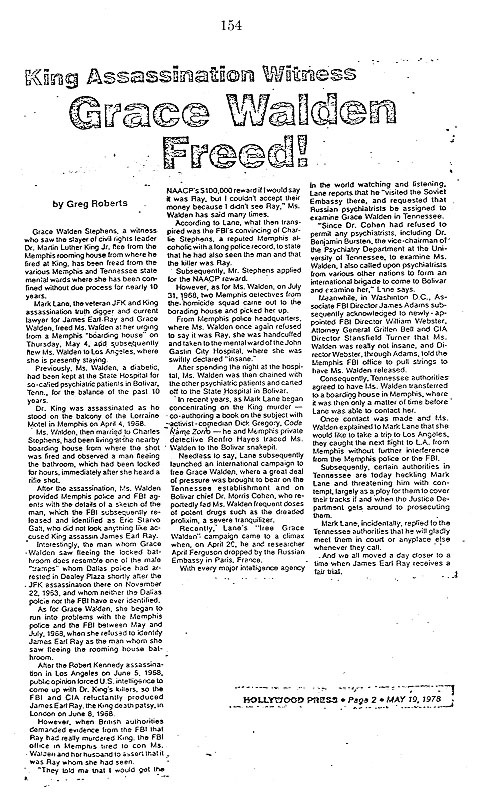
King Assassination Witness
Grace Walden Freed!
by Greg Roberts
Grace Walden Stephens, a witness who saw the slayer of civil rights leader Dr. Martin Luther King Jr. flee from the Memphis rooming house from where he fired at King, has been freed from the various Memphis and Tennessee state mental wards where she has been confined without due process for nearly 10 years.
Mark Lane, the veteran JFK and King assassination truth digger and current lawyer for James Earl Ray and Grace Walden, freed Ms. Walden at her urging from a Memphis "boarding house" on Thursday, May 4, and subsequently flew Ms. Walden to Los Angeles, where she is presently staying.
Previously, Ms. Walden, a diabetic, had been kept at the State Hospital for so-called psychiatric patients in Bolivar, Tenn., for the balance of the past 10 years.
Dr. King was assassinated as he stood on the balcony of the Lorraine Motel in Memphis on April 4, 1968.
Ms. Walden, then married to Charles Stephens, had been living at the nearby boarding house from where the shot was fired and observed a man fleeing the bathroom, which had been locked for hours, immediately after she heard the rifle shot.
After the assassination, Ms. Walden provided Memphis police and FBI agents with the details of a sketch of the man, which the FBI subsequently released and identified as Eric Starvo Galt, who did not look anything like accused King assassin James Earl Ray.
Interestingly, the man whom Grace Walden saw fleeing the locked bathroom does resemble one of the male "tramps" whom Dallas police had arrested in Dealey Plaza shortly after the JFK assassination there on November 22, 1963, and whom neither the Dallas police nor the FBI have ever identified.
As for Grace Walden, she began to run into problems with the Memphis police and the FBI between May and July, 1968, when she refused to identify James Earl Ray as the man whom she saw fleeing the rooming house bathroom.
After the Robert Kennedy assassination in Los Angeles on June 5, 1968, public opinion forced U.S. intelligence to come up with Dr. King's killers, so the FBI and CIA reluctantly produced James Earl Ray, the King death patsy, in London on June 8, 1968.
However, when British authorities demanded evidence from the FBI that Ray had really murdered King, the FBI office in Memphis tried to con Ms. Walden and her husband to assert that it was Ray whom she had seen.
"They told me that I would get the NAACP's $100,000 reward if I would say it was Ray, but I couldn't accept their money because I didn't see Ray," Ms. Walden has said many times.
According to Lane, what then transpired was the FBI's convincing of Charlie Stephens, a reputed Memphis alcoholic with a long police record, to state that he had also seen the man and that the killer was Ray.
Subsequently, Mr. Stephens applied for the NAACP reward.
However, as for Ms. Walden, on July 31, 1968, two Memphis detectives from the homicide squad came out to the boarding house and picked her up.
From Memphis police headquarters, where Ms. Walden once again refused to say it was Ray, she was handcuffed and taken to the mental ward of the John Gastin City Hospital, where she was swiftly declared "insane."
After spending the night at the hospital, Ms. Walden was then chained with the other psychiatric patients and carted off to the State Hospital in Bolivar.
In recent years, as Mark Lane began concentrating on the King murder -- co-authoring a book on the subject with activist-comedian Dick Gregory, Code Name Zorro -- he and Memphis private detective Renfro Hayes traced Ms. Walden to the Bolivar snakepit.
Needless to say, Lane subsequently launched an international campaign to free Grace Walden, where a great deal of pressure was brought to bear on the Tennessee establishment and on Bolivar chief Dr. Morris Choen, who reportedly fed Ms. Walden frequent doses of potent drugs such as the dreaded prolixim, a severe tranquilizer.
Recently, Lane's "free Grace Walden" campaign came to a climax when, on April 20, he and researcher April Ferguson dropped by the Russian Embassy in Paris, France.
With every major intelligence agency in the world watching and listening, Lane reports that he "visited the Soviet Embassy there, and requested that Russian psychiatrists be assigned to examine Grace Walden in Tennessee.
"Since Dr. Cohen had refused to permit any psychiatrists, including Dr. Benjamin Bursten, the vice-chairman of the Psychiatry Department at the University of Tennessee, to examine Ms. Walden, I also called upon psychiatrists from various other nations to form an international brigade to come to Bolivar and examine her," Lane says.
Meanwhile, in Washington, D.C., Associate FBI Director James Adams subsequently acknowledged to newly-appointed FBI Director William Webster, Attorney General Griffin Bell and CIA Director Stansfield Turner that Ms. Walden was really not insane, and Director Webster, through Adams, told the Memphis FBI office to pull strings to have Ms. Walden released.
Consequently, Tennessee authorities agreed to have Ms. Walden transferred to a boarding house in Memphis, where it was then only a matter of time before Lane was able to contact her.
Once contact was made and Ms. Walden explained to Mark Lane that she would like to take a trip to Los Angeles, they caught the next flight to L.A. from Memphis without further interference from the Memphis police or the FBI.
Subsequently, certain authorities in Tennessee are today heckling Mark Lane and threatening him with contempt, largely as a ploy for them to cover their tracks if and when the Justice Department gets around to prosecuting them.
Mark Lane, incidentally, replied to the Tennessee authorities that he will gladly meet them in court or anyplace else whenever they call.
And we all moved a day closer to the time when James Earl Ray receives a fair trial.
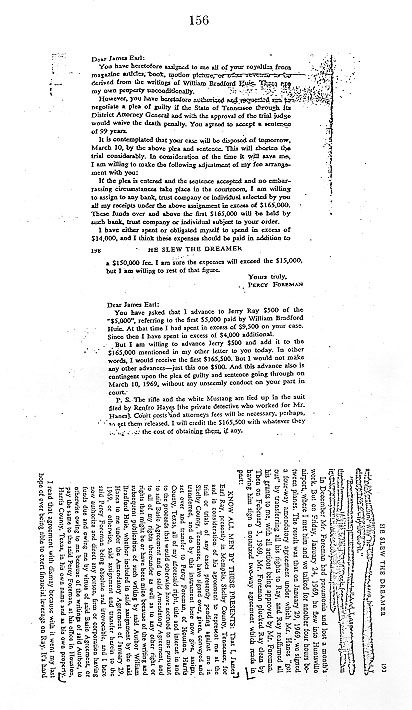
Excerpts from the book He Slew The Dreamer by William Bradford Huie]
Dear James Earl:
You have heretofore assigned to me all of your royalties from magazine articles, book, motion picture, or other revenue to be derived from the writings of William Bradford Huie. These are my own property rights unconditionally.
However, you have heretofore authorized and requested me to negotiate a plea of guilty if the State of Tennessee through its District Attorney General and with the approval of the trial judge would waive the death penalty. You agreed to accept a sentence of 99 years.
It is contemplated that your case will be disposed of tomorrow, March 10, by the above plea and sentence. This will shorten the trail considerably. In consideration of the time it will save me, I am willing to make the following adjustment of my fee arrangement with you:
If the plea is entered and the sentence accepted and no embarrassing circumstances take place in the courtroom, I am willing to assign to any bank, trust company or individual selected by you all my receipts under the above assignment in excess of $165,000. These funds over and above the first $165,000 will be held by such bank, trust company or individual subject to your order.
I have either spent or obligated myself to spend in excess of $14,000, and I think these expenses should be paid in addition to a $150,000 fee. I am sure the expenses will exceed the $15,000, but I am willing to rest of that figure.
Yours truly,
Percy Foreman
Dear James Earl:
You have asked that I advance to Jerry Ray $500 of the "$5,000", referring to the first $5,000 paid by William Bradford Huie. At that time I had spent in excess of $9,500 on your case. Since then I have spent in excess of $4,000 additional.
But I am willing to advance Jerry $500 and add it to the $165,000 mentioned in my other letter to you today. In other words, I would receive the first $165,000. But I would not make any other advances -- just this one $500. And this advance also is contingent upon the plea of guilty and sentence going through on March 10, 1969, without any unseemly conduct on your part in court.
P.S. The rifle and the white Mustang are tied up in the suit filed by Renfro Hayes [the private detective who worked for Mr. Hanes]. Court costs and attorneys fees will be necessary, perhaps, to get them released. I will credit the $165,000 with whatever they [illegible] the cost of obtaining them, if any.
HE SLEW THE DREAMER 193
[several illegible lines]
In December Mr. Foreman had pneumonia and lost a month's work. But on Friday, January 24, 1969, he flew into Huntsville airport, where I met him and we talked for another four hours between planes. The result was that on January 29, 1969, we signed a four-way amendatory agreement under which Mr. Hanes "got out" by transferring all his rights to Ray, and Ray reaffirmed all his grants to me, with all actions being approved by Mr. Foreman. Then on Febuary 3, 1969, Mr. Foreman plucked Ray clean by having him sign a notarized two-way agreement which reads in part:
KNOW ALL MEN BY THESE PRESENTS: That I, James Earl Ray, presently in Memphis, Shelby County, Tennessee, for and in consideration of his agreement to represent me at the trial or trials of any cases presently pending against me in Shelby County, Tennessee, have signed over, given, conveyed and transferred, and do by this instrument here and now give, assign, set over and transfer to Percy Foreman, of Houston, Harris County, Texas, all of my aforesaid right, title and interest in and to the proceeds that would otherwise have accrued to me pursuant to said Basic Agreement and to said Amendatory Agreement, and to all of my rights thereunder as well as to any other right or rights that might be or have been mine because of the writing and subsequent publication of such writing by said Author William Bradford Huie, whether included in said assignment by the said Hanes to me under the Amendatory Agreement of January 29, 1969, or otherwise, said assignment and transfer herein to the said Percy Foreman being absolute and irrevocable, and I here now authorize and direct any person, firm or corporation having funds due and owing me by virtue of said Basic Agreement, or otherwise owing to me because of the writings of said Author, to pay the same to the said Percy Foreman, at his office in Houston, Harris County, Texas, in his own name and as his own property.
I read that agreement with dismay because with it went my last hope of ever being able to exert financial leverage on Ray. It's hard
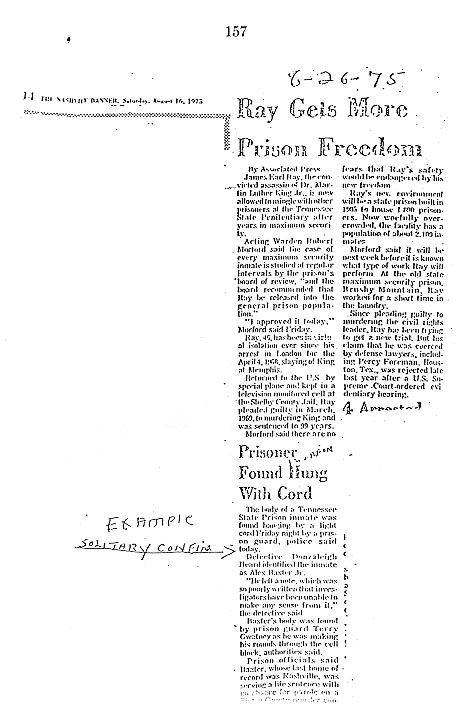
14 THE NASHVILLE BANNER, Saturday, August 16, 1975
8-26-75
Ray Gets More Prison Freedom
By Associated Press
James Earl Ray, the convicted assassin of Dr. Martin Luther King Jr., is now allowed to mingle with other prisoners at the Tennesses State Penitentiary after years in maximum security.
Acting Warden Robert Morford said the case of every maximum security inmate is studied at regular intervals by the prison's board of review, "and the board recommended that Ray be released into the general prison population."
"I approved it today," Morford said Friday.
Ray, 45, has been in virtual isolation ever since his arrest in London for the April 4, 1968, slaying of King at Memphis.
Returned to the U.S. by special plane and kept in a television monitored cell at the Shelby County Jail, Ray pleaded guilty in March, 1969, to murdering King and was sentenced to 99 years.
Morford said there are no fears that Ray's safety would be endangered by his new freedom.
Ray's new environment will be a state prison built in 1905 to house 1500 prisoners. Now woefully overcrowded, the facility has a population of about 2,109 inmates.
Morford said it will be next week before it is known what type of work Ray will perform. At the old state maximum security prison, Brushy Mountain, Ray worked for a short time in the laundry.
Since pleading guilty to murdering the civil rights leader, Ray has been trying to get a new trial. But his claim that he was coerced by defense lawyers, including Percy Foreman, Houston, Tex., was rejected late last year after a U.S. Supreme Court-ordered evidentiary hearing.
[handwritten note: "example solitary confine-----"]
Prisoner Found Hung With Cord
The body of a Tennessee State Prison inmate was found hanging by a light cord Friday night by a prison guard, police said today.
Detective Donzaleigh Heard identified the inmate as Alex Baxter Jr.
"He left a note which was so poorly written that investigators have been unable to make any sense from it," the detective said.
Baxter's body was found by prison guard Terry Gwatney as he was making his rounds through the cell block, authorities said.
Prison officials said Baxter, whose last home of record was Nashville, was serving a life sentence with [illegible] Byers Knew of Ray Payoff, Informant Told FBI in 1973
WASHINGTON -- The Federal Bureau of Investigation received information in 1973 that Russel G. Byers, a former auto parts dealer and police character from Rock Hill, Mo., knew who "made the payoff of James Earl Ray" after the assassination of the Rev. Dr. Martin Luther King Jr.
Byers' accusation, reported by an informant, is contained in an internal St. Louis FBI office memorandum made available Wednesday to the Post-Dispatch under the Freedom of Information Act.
The memorandum, which went unnoticed for four years in the wrong file in St. Louis, does not give the name of the man identified by Byers. But it describes the man as "a short, stocky man who walked with a limp."
This description, several sources have told the Post-Dispatch, fits John R. Kauffmann, a one-time stockbroker of Imperial, Mo. Byers has reportedly told investigators for the House Assassinations Committee that Kauffmann and John H. Sutherland, both now dead, asked Byers to arrange King's murder.
Byers refused to comment on the FBI memo when reached at his Rock Hill home Wednesday night. He said the House committee had asked him not to make public statements.
Byers was keenly interested, however, in the new disclosures. He carefully analyzed the copy of the FBI memo released Wednesday. And, while humming a tune, he read through a New York Times story about the memo.
Byers' allegations are currently under scrutiny by the House Committee on Assassinations. A committee source told the Post-Dispatch Wednesday night that the committee was still trying to assess the significance of Byers' story.
All names but that of Byers were deleted from the FBI memorandum by the Freedom of Information Privacy Acts Branch. But the memorandum discussed a meeting among Byers and two men in which Byers said he "had been offered either $10,000 or $20,000 to kill King."
Sources have told the Post-Dispatch that Byers told House investigators that Kauffman and Sutherland, a patent lawyer, also from Imperial, asked him to arrange King's murder.
The memorandum, dated March 19, 1974, was written by a St. Louis agent of the FBI on the basis of information supplied by an informant.
"In the fall of 1973," the memorandum reads, "Beyers (the name is consistently spelled in the memo) talked freely about himself and his business, and they later went to (short deletion by FBI) where Beyers told a story about visiting a lawyer in St. Louis County, now deceased not further identified, who had offered to give him a contract to kill Martin Luther King. He said that also present was a short, stocky man who walked with a limp."
The memorandum then continues with this sentence, enclosed in parentheses:
"(Later, with regard to the latter individual, Beyers commented that this man was actually the individual who made the payoff of James Earl Ray after the killing.)"
Several sources have told the Post-Dispatch that Kauffman was short, overweight and walked with a marked limp after being injured in an automobile accident several years prior to the events described by Byers.
One source said that accident also seemed to have impaired Kauffmann mentally. "He was a completely different man after that." In fact, when Kauffmann was arrested in 1967 for selling 500,000 amphetamine pills to a federal agent he asked his attorney if he could plead innocent by reason of insanity, the source said. That idea was abandoned, however, and Kauffmann was convicted. Kauffman, a stockbroker and businessman, died in 1973.
His wife Beulah G. Kauffmann testified for about three hours last week before the House select committee.
The committee did not ask her about the allegation that a "short, stocky main, who walked with a limp," had paid off Ray, the Post-Dispatch was told by a source familiar with her interrogation. Mrs. Kauffmann refused to discuss the
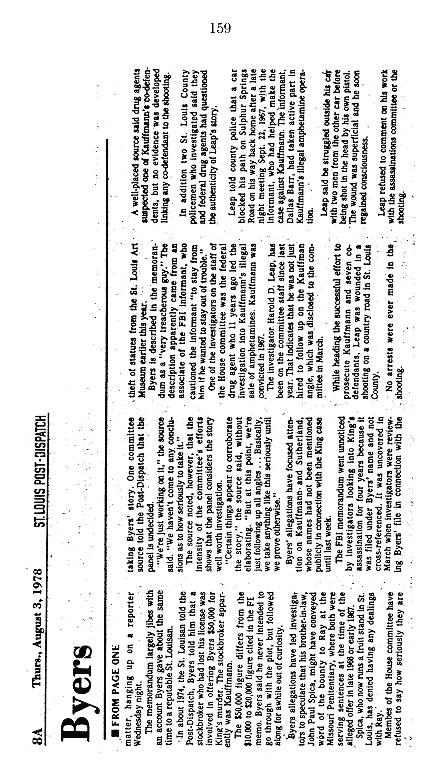
8A Thurs., August 3, 1978 ST. LOUIS POST-DISPATCH
BYERS
--From Page One
matter, hanging up on a reporter Wednesday night.
The memorandum largely jibes with an account Byers gave about the same time to a reputable St. Louisan.
In about 1974, the St. Louisan told the Post-Dispatch, Byers told him that a stockbroker who had lost his license was involved in offering Byers $50,000 for King's murder. The stockbroker apparently was Kauffman.
The $50,000 figure differs from the $10,000 to $20,000 figure cited in the FBI memo. Byers said he never intended to go through with the plot, but followed along for awhile out of curiosity.
Byers allegations have led investigators to speculate that his brother-in-law, John Paul Spica, might have conveyed word of the bounty to Ray at the Missouri Penitentiary, where both were serving sentences at the time of the alleged offer in late 1966 or early 1967.
Spica, who now runs a fruit stand in St. Louis, has denied having any dealings with Ray.
Members of the House committee have refused to say how seriously they are taking Byers' story. One committee source told the Post-Dispatch that the panel is undecided.
"We're just working on it," the source said. "We haven't come to any conclusions as to how seriously to take it."
The source noted, however, that the intensity of the committee's efforts shows that the panel considers the story well worth investigation.
"Certain things appear to corroborate the story," the source said, without elaborating. "But at this point, we're just following up all angles... Basically, we take anything like this seriously until we prove otherwise."
Byers' allegations have focused attention on Kauffmann and Sutherland, whose names have not been mentioned publicly in connection with the King case until last week.
The FBI memorandum went unnoticed by investigators looking into King's assassination for four years because it was filed under Byers' name and not cross-referenced. It was uncovered in March when investigators were reviewing Byers' file in connection with the theft of statues from the St. Louis Art Museum earlier this year.
Byers is described in the memorandum as a "very treacherous guy." The description apparently came from an associate of the FBI informant, who cautioned the informant "to stay from him if he wanted to stay out of trouble."
One of the investigators on the staff of the House committee was the federal drug agent who 11 years ago led the investigation into Kauffmann's illegal sale of amphetamines. Kauffmann was convicted in 1967.
The investigator Harold D. Leap, has been on the committee staff since last year. That indicates that he was not just hired to follow up on the Kauffman angle, which was disclosed to the committee in March.
While heading the unsuccessful effort to prosecute Kauffman and seven co-defendants, Leap was wounded in a shooting on a country road in St. Louis County.
No arrests were ever made in the shooting.
A well-placed source said drug agents suspected one of Kauffmann's co-defendants, but no evidence was developed linking any co-defendant to the shooting.
In addition two St. Louis County policemen who investigated said they and federal drug agents had questioned the authenticity of Leap's story.
Leap told county police that a car blocked his path on Sulphur Springs Road on his way back home after a late night meeting Sept. 22, 1967, with the informant, who had helped make the case against Kauffmann. The informant, Dallas Barr, had taken active part in Kauffmann's illegal amphetamine operation.
Leap said he struggled outside his car with two men from the other car before being shot in the head by his own pistol. The wound was superficial and he soon regained consciousness.
Leap refused to comment on his work with the assassinations committee or the shooting.
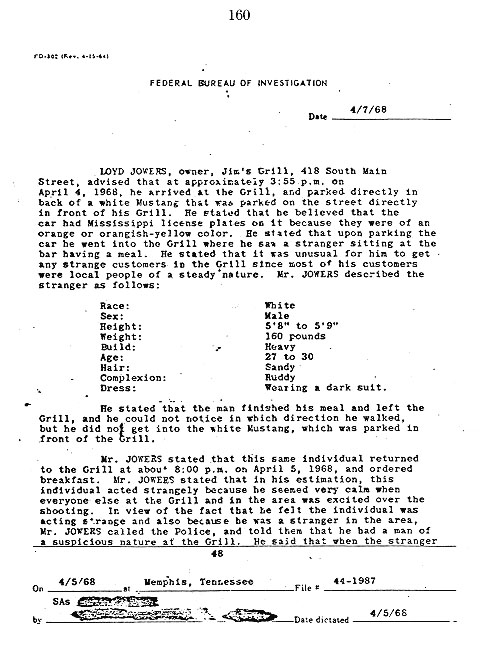
FEDERAL BUREAU OF INVESTIGATION
Date 4/7/68
LOYD JOWERS, owner, Jim's Grill, 418 South Main Street, advised that at approximately 3:55 p.m. on April 4, 1968, he arrived at the Grill, and parked directly in back of a white Mustang that was parked on the street directly in front of his Grill. He stated that he believed that the car had Mississippi license plates on it because they were of an orange or orangish-yellow color. He stated that upon parking the car he went into the Grill where he saw a stranger sitting at the bar having a meal. He stated that it was unusual for him to get any strange customers in the Grill since most of his customers were local people of a steady nature. Mr. JOWERS described the stranger as follows:
Race: White
Sex: Male
Height: 5'8" to 5'9"
Weight: 160 pounds
Build: Heavy
Age: 27 to 30
Hair: Sandy
Complexion: Ruddy
Dress: Wearing a dark suit.
He stated that the man finished his meal and left the Grill, and he
could not notice in which direction he walked, but he did not get into the
white Mustang, which was parked in front of the Grill.Mr. JOWERS stated that this same individual returned to the Grill at about 8:00 p.m. on April 5, 1968, and ordered breakfast. Mr. JOWERS stated that in his estimation, this individual acted strangely because he seemed very calm when everyone else at the Grill and in the area was excited over the shooting. In view of the fact that he felt the individual was acting strange and also because he was a stranger in the area, Mr. JOWERS called the Police, and told them that he had a man of a suspicious nature at the Grill. He said that when the stranger finished his breakfast, he left the Grill and was arrested on the sidewalk in front of the Grill by the Memphis Police Department.
[deletion] Homicide Bureau, Memphis Police Department, later identified this arrested individual as GENE PEARSON CRAWFORD, [deletion] Jackson, Tennessee, who was determined to have had no part in the murder of Dr. MARTIN LUTHER KING, JR.
On 4/5/68 at Memphis, Tennessee File # 44-1987
SAs [deletion]
by [deletion] Date dictated 4/5/68
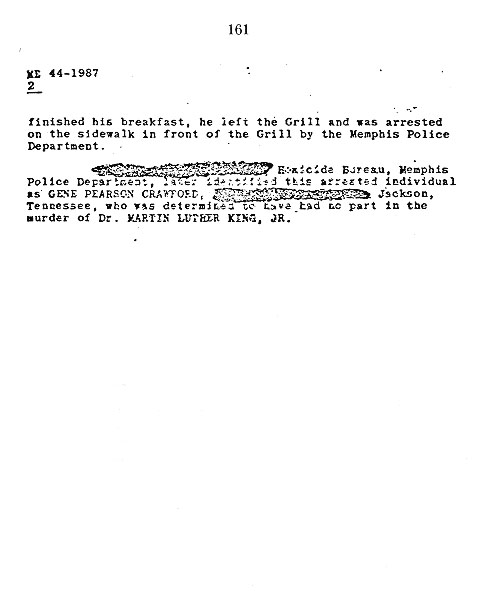
Retired FBI Agent and Police Chief Don Adams,
who was one of the original investigators in Dallas
examining the JFK assassination, stumbles upon records
and reports that were doctored. He knows, because he
filed the original reports. His decade long investigation
has taken him deep into history, to the National Archives
and beyond. Step by step he says he has learned and can
prove that Lee Harvey Oswald did not kill JFK.
Let us not seek the Republican answer or the Democratic answer, but the right answer. Let us not seek to fix the blame for the past. Let us accept our own responsibility for the future.
John F. Kennedy

ANITTA

MC Melody
Bike Grip Board
The lies and deceit in this phone conversation between 2 supposedly 'honorable men' are overwhelming. President Lyndon B. Johnson and FBI Director-J. Edgar Hoover conspire to keep the world in the dark as they have an ego pumping session shortly after JFK's killing. CLICK HERE to hear the entire, disturbing, and incredible private conversation. If the link doesn't work you can copy and paste this URL into your Web Browser address box. https://garyrevel.com/jfk/lbjjedgarhooverconspires.html
MLK-They Slew the Dreamer Presentation
Page 1MLK Assassination Investigation Links
Copies of pages from the transcript of the James Earl Ray guitly plea hearing and analysis by Special Investigator Gary Revel
Investigating the Assassination of Martin Luther King Jr. - People get Killed
Leutrell Osborne Finds Disturbing New Details Investigating Martin Luther King Jr. Assassination
MLK Conspiracy Trial-Transcript
Mystery Helicopter and Riot Control in Memphis During March with MLK
New Questions About E. Howard Hunt And MLK Assassination-A Gary Revel Commentary
Pictures of Assassins
The Case Against James Earl Ray: Anyalysis by Martin Hay
The Deadly Business of the Murder of Martin Luther King Jr.
They Slew the Dreamer - Lyrics and History
More Assassination Research Links
3 Tramps in Dealy Plaza: What are they to JFK killing
Adam Gorightly Interview by Investigative Journalist Bob Wilson
Abraham Bolden-Book Review-Echo From Dealey Plaza
Anti-Castro Cuban exile, Antonio Veciana met with CIA Handler and Oswald
Badgeman: Do you see him and did he kill JFK?
Beverly Oliver Interview-Eyes Wide Shut
Christopher Dodd and the MLK/JFK Assassinations
Bob Wilson Interview with Mort Sahl
Carlos Marcello's Hideout in Swamp by Gary Revel
Chief Curry, the FBI and Assassination of JFK
Conspired to Kill: Opinion by Gary Revel
Deep Throat Surfaces - Watergate and Assassinations
Was Demohrenschildt CIA and Part of JFK Assassination Team?
Download PDF of the CIA's FAMILY JEWELS - FREE
Gary Revel interview on guilt/innocence of Lee Harvey Oswald
Interviedw of Joseph Mcbride
Interviedw of Joan Mellen
Into the Nightmare-Mcbride Book Review
Gayle Nix Interview-JFK Assassination
JFK and RFK: The Plots that Killed Them, The Patsies that Didn’t by James Fetzer
JFK Assassination Bullet Fragment Analysis Proves Second Shooter
JFK Assassination Film
by Orville Nix with interview where he says the shot came
from the fence not the Texas Book Depository.
JFK Assassination Invetigation Continues
JFK: In The Light of Day by Gary Revel
JFK: In The Light of Day Update by Gary Revel
JFK: Robert Kennedy-Rollingstone Article
JFK: The Real Story-Movie Project
JFK: Through the Looking Glass Darkly
JFK: Why and How the CIA Helped Kill Him
Mikhail Kryzhanovsky tells it like it is.
Russo, Oswald, Ferrie and Shaw
Shane O'Sullivan Interview
John Whitten: How the CIA Helped Kill JFK and Keep Their Guilt Hidden
Judd Apatow tweets his displeasure with theaters delaying opening of THE INTERVIEW (movie about a CIA plan to assassinate North Korea's Kim Jung Un) due to the GOP's terrorist threats.
RED POLKA DOT DRESS: Movie project, the mystery of the assassination of Senator/Presidential Candidate Robert F. Kennedy; screenplay by Frank Burmaster and Gary Revel.
The business of murder related to Santo Trafficante, the Mafia, the CIA, JFK, MLK and RFK
The Girl on the Stairs says Oswald did not pass her after the shooting of JFK
The Mystery of Roger Craig and the JFK Assassination
How the CIA Kept Secrets From the HSCA
Why and How the CIA Helped Assassinate JFK
John Lennon Assassination
A Not So Funny Thing Happened: (WHILE LOOKING INTO THE MURDER OF AN EX- BEATLE)
John Lennon and ...
John Lennon killing, Wanna be a hero?
RSS Feed: Gary Revel MLK Assassination Investigation
Gary Revel found links to those responsible for the assassinations of JFK, MLK, RFK, John Lennon and the attempted killing of President Ronald Reagan.
A VERY INTERESTING PHONE CONVERSATIONThe lies and deceit in this phone conversation between 2 supposedly 'honorable men' are overwhelming. President Lyndon B. Johnson and FBI Director-J. Edgar Hoover conspire to keep the world in the dark as they have an ego pumping session shortly after JFK's killing. CLICK HERE To hear the entire, disturbing, and incredible private conversation. If the link doesn't work you can copy and paste this URL into your Web Browser address box. https://garyrevel.com/jfk/lbjjedgarhooverconspires.html
Owner of Jongleur Music Group of companies that includes music publishing/production/distribution, movie development, and book publishing.
https://garyrevel.com
Email: gary@garyrevel.com
Website Copyright 2006-2017 by Gary Revel